Impact of Work-Life Balance on Productivity in the Film Industry
Info: 16912 words (68 pages) Dissertation
Published: 25th Aug 2021
Tagged: EmploymentManagement
Abstract
Purpose: Work-life balance is a crucial aspect in employees’ life working in the film industry. Thus, the purpose of this research paper is to study the effect of work-life balance on productivity of the employees at Narimon Film Company.
Design/Methodology/Approach: The primary and secondary research have been conducted in order to collect valid as well as reliable data and answer the research question. Additionally, the approach of the study was inductive, which helped to get independence during the research process. The research was based on semi-structured interviews with the director and the employees of Narimon Film and filming process observations. The information from both research have been analysed through ‘QDA Miner qualitative data analysis’ tool that helped to find the positive as well as negative factors influencing the employees’ productivity at Narimon Film Company.
Findings: The results of the primary research,partially, coincided with the previous studies conducted by other scholars. It was revealed that there are three main factors that may influence the productivity in the film industry: health, stress and family. However, as regards to Narimon Film, such factors as family issues and incompetent colleagues may significantly affect their creativity and time-management, respectively, during performing a film process. Moreover, it was identified that the company implements strategies and programs, which maintain the balance between work and life.
Practical Implications: The Company, in order to develop the current work-life balance and increase the productivity level, may implement the results and analyses of the research. However, the results may not be used by other industries because the findings are based on the employees of Narimon Film Company that operates in the film Industry.
Originality/Value: This research may be considered as the first one that is based on the work-life balance and productivity in the film industry in Uzbekistan. It may provide the valuable information about the work-life balance for the companies that operate in the same industry, in Uzbekistan.
Contents
Research Question and Objectives
Components of Work-Life Balance
Work-Life Balance and Conflict
Work-Life Balance and Productivity
Implications for further research
Observation Forms (Appendix 1)
Satisfaction level (Appendix 4)
Weather for 23.12.2015 (Appendix 5)
Introduction
The work in the film industry “is not always as glamorous as it seems” (Royster and Vilorio, 2013). It consists of such complications as stress and long working hours and entails the involvement of people specializing in other professions of diverse domains along with the film industry. Additionally, the most essential key performance indicators of a company’s productivity in the film industry are ascribed to budget allocation, technology exploitation and time assignation (Telefilm Canada, 2012). The mentioned key performance indicators may have a positive influence on the quality of a final project.
The development of a culture of successful work-life balance occupies an increasingly profound concern among employers as well as employees in the majority of business entities. Subsequently, for the period of the last several decades, most organizations have contributed to the development of work-life balance due to satisfying the personal needs of their staff. However, in fact, some workplace factors are invading the privacy of people’s lives that may eventually cause stress.
According to Sahadi (2015), on average, 70 percent of the respondents state that the factor of ‘bad bosses’ is the main reason the negative work-life balance is accentuated with. In addition, such stressful factors as ‘long office hours, incompetent colleagues as well as long commutes’ provide a significant influence on employees, 39, 31 and 30 percent correspondingly. As a result, such practices impact on “workers physiologically and psychologically”, which in turn have influence on workers’ productivity (Fapohunda, 2014).
Moreover, Third European Working Conditions Survey (henceforth EWCS) (2000) in their turn, indicate the correlation between working hours and health. According to the research, extended office hours have repercussions on health deterioration such as headaches, muscular pain, insomnia and stress (cited in Fagan et al., 2011). Based on this, some researchers have galvanized their interest in identifying the relations between personal life of an individual and work productivity in organizations. Most of the studies have explored the direct relationship between work-life balance and performance of an employee. (Isamu and Toshiyuki, 2012). However, the results of other authors have not indicated the relationship between mentioned concepts (Bloom et al., 2009).
In addition, the scholars provide several characteristics as well as sources of work-life balance. The main sources of the work-life balance development are the changes in demographics, technology, average income, work and family atmosphere (Shankar and Bhatnagar, 2010). Most of the authors raise disputes about the characteristics, concepts and impacts of work-life balance.
This research paper is focused on providing a clear understanding of work-life balance impact on employees’ productivity in the case of Narimon Film Company.
Research Question and Objectives
How does work-life balance affect productivity at Narimon Film Company?
- To examine current work-life balance of employees at the company
- To identify and analyze the major Key Performance Indicators of employees’ productivity at Narimon Film Company
- To identify influence between work-life balance of employees and their productivity at work
Literature Review
According to Royster and Vilorio (2013), the film industry consists of the challenging occupations, where such complications as stress and long working hours may occur. The entire staff such as directors, cinematographers, editors, actors as well as technicians are partially engaged in the process of filming, which means that the responsibility for the quality of the final project is shared among the involved personnel. Royster and Vilorio (2013) cite that “stress is common for filmworkers, in large part because they typically face inflexible deadlines.” Bickford (2005) notes that stress is a significant factor that directly or indirectly affects the early and premature deaths. Therefore, it is recommended to prevent employees by providing the physical and mental wellbeing through the ordinary relaxation techniques. For example, ‘progressive muscle relaxation’, meditation as well as deep breathing may help to appease the muscular tonus, stabilize ‘the pulse and heart rate’ (ibid). Moreover, the quality of movies produced by a Film Company and the productivity of employees directly depends on the budget allocated, people involved and time allotted (DeVany and Walls, 1999; Young et al., 2008). Consequently, erratic work-life balance may affect the budged of the movie and result in the profit drop of the Film Company (Bird, 2006).
Work-Life Balance
Work-life balance is an equal combination of engagement and satisfaction of an individual’s work and family roles (Greenhaus, 2003). Hence, the basic feature of work-life balance concept is the number of hours performed by an employee. Consequently, the degree of flexibility, desired and proposed by an employee and employer, does not necessarily correspond to the reality (Fagan et al., 2011). Therefore, an organization is required to develop strategies in order to solve arisen issues with the balance between work and life to enhance employees’ productivity (Tremblay, 2012). Meanwhile, Tulasidas (2015) reveals that work-life balance conception is a cornerstone of ‘job duties or personal obligations’ process of prioritizing. In other words, an employee may allocate the work responsibilities evenly accentuating them in the order of significance and urgency. For instance, such duties and obligations underlie in reviews and analyses of corporate reports or in parent meetings at schools. The program of successful work-life balance can also negatively influence the concept of productivity by increasing absenteeism level (ibid).
Components of Work-Life Balance
Davidson (2014) identifies six main components of work-life balance such as self-, time-, stress-, change-, technology- and leisure- management types. Generally, in order to achieve successful work-life balance, a person has to receive the most consequential physiological requirements (sufficient sleep, balanced nutrition as well as exercising). Additionally, the time should be managed optimally between job obligations and personal issues. EWCS (2000) reveals that the amount of work produced by an employee has a maleficent effect on health (cited in Fagan et al., 2011).
As regards stress management, employees are obliged to maintain serenity and control tension in difficult situations related to family problems or stress at work. Moreover, an employee should seamlessly adopt changes at work and at home, in order to overcome them without tension. In addition, the development of technologies helps employees to be more flexible, productive and efficient. An organization has to be responsible for rest, comfort and gratification (Tremblay, 2012).
However, the case study explored by Doherty and Manfredi (2003) focused on the organization that not only provides much flexibility to part-time members of staff, but also introduces onerous workload that deteriorates the performance and productivity of employees. As a result, the organization fails to achieve sustainable work-life balance. Nevertheless, Arizona Employers’ Council, Inc. (henceforth AEC) argues that written policies as flexible time plans, set according to corporate needs and staff analysis, could minimize potential issues (2004). In addition, Eikhof et al. (2007) cite that “…work can have a debilitating effect on life…” and introduces various solutions to the problem with time flexibility.
Moreover, according to Alliance for Work-Life Progress (henceforth AWLP) employers need to provide support and benefits for employees in high-quality childcare and elderly care (2011). Rantanen et al. (2011) assert that the impact of a successful dependent care support provides less stress and better health of employees that can be auspiciously reflected on productivity. In addition, health and wellness approaches in the workplace are a sign of effective work-life. Such programs as ‘employee assistant programs, health promotion initiatives, fitness center membership as well as seminars with employees’ are the illustrative examples of strong work-life balance. Meanwhile, structured financial support as well as paid and unpaid time off categories are fundamental to the successful work-life. Finally, in order to achieve close alignment between employee and management to overhead barriers of full engagement and productivity, the staff should be involved in organizational community and follow organizational culture (AWLP, 2011).
Work-Life Balance and Conflict
Nevertheless, the above-mentioned factors may lead an organization to work-life conflict. Bell et al. (2012) cite that term of work-life conflict originates “… when involvement in one domain interferes … with involvement in the other domain”. Hence, the low level of work-life balance is a consequence of high work-life conflict. According to Allen et al. (2000) high work-life conflict results from family instability, health and stress-related issues and employees’ exhaustion all of which eventually result in their low productivity and dissatisfaction. Companies, due to these negative effects, experience unavoidable staff shortage (cited in Bell et al., 2012).
Work-Family Conflict
According to European Agency for Safety and Health at Work (n.d) work-family conflict is an outcome of emotional or physical strain obtained at work that affects families’ stability (henceforth EU-OSHA). The results of the conflict are based on such components as time-, involvement- and satisfaction-balances.
Furthermore, the high level of work-life conflict may lead to depression, “physical ailments”, “somatic complaints” and “incidence of hypertension” (Googins, 1991; Frone et al., 1997; Burke, 1988 cited in Grant-Vallone and Donaldson, 2001). Therefore, according to the results, 74 percent of respondents affirm that they cannot allocate sufficient time for their families (Fapohunda, 2014). Hence, organizations have to implement strategic management of family and work concepts in order to increase the level of employees’ satisfaction and productivity. EU-OSHA (n.d) proposes to a business entity to take into consideration such characteristics as reduced working hours, flexible schedules, 5-day workweeks and underemployment in order to have positive influence on efficiency of the work-life balance practices within the organization.
Health and Stress
A number of empirical scholars have conducted studies on the impact of work-life balance on employees’ productivity (Sivatte et al., 2015; Fapohunda, 2014; Greenhaus et al., 2003; Bloom et al., 2006). Proper identification of work-life balance has become pervasive among employees as well as their employers. Most researchers have extensively investigated the work-life programs as flexible schedules, wellness programs, and childcare services in different companies (Sivatte et al., 2015). According to Fapohunda (2014), the amount of time spent at work is the main characteristic of work-life balance. Scholastic findings show how the volume of excessive working hours affects employees’ health, undermines their safety and facilitates stress. To exemplify, such overload contributes to serious cardio-vascular diseases, such as strokes and heart attacks, all presumably resulting from chronic work-stress, inconsistent and extended shifts and substance abuse (Burke and Cooper, 2008; Chandola et al., 2008; Knuttson et al., 1986 cited in Fagan et al., 2011).
Conversely, Greenhaus et al. (2003) assert that “work-life balance” as a term, besides the time balance, also considers the balance of satisfaction and involvement (cited in Bradley et al., 2006). Hence, work-life balance is perceived as the balance of satisfaction degree obtained during work activities in comparison with activities related to out-of-work experience. Moreover, Greenhaus et al. (2003) note that the balance of involvement is measured by the amount of psychological engagement in work rather than in a personal life (cited in Rantanen et al., 2011).
In their turn, Clark (2000); Clarke et al. (2004); Marks and MacDermid (1996) affirm that the significance of work-life balance mostly relies on psychological well-being of an individual that can emanate from the sense of harmony, satisfaction at work as well as high self-esteem (cited in Rantanen et al., 2011). The main factors, that exert pressure of work-life balance, are long working hours, unpaid overtime as well as work intensification (Green, 2001; Taylor, 2001; Hyman et al., 2003 cited in Hyman and Summers, 2007). Similarly, Cooper (2000) considers that the mentioned factors, in their turn, have a negative effect on stress-related issues (ailments and sluggishness) (cited in Hyman and Summers, 2007). Consequently, according to the studies of researches above, such factors as time management as well as satisfaction and involvement levels of employees have to be scrupulously considered while conducting the research at NarimonFilm Company.
Employee Burnout
Several studies have investigated the negative trends of work-life balance. Kofodimos (1993) states that uneven distribution of responsibilities may develop ‘depressed and dissatisfied staff’ (cited in Mukhtar, 2012). The main reason of dissatisfaction of an employee that results in the aftermath is disparity. For instance, inequity may arise, between part-time and full-time employees. Additionally, Hamming and Bauer (2009)assert that unsuccessful implementation of work-life balance practices will develop issues related to emotions, energy, depression and pessimism. The negative influence on these factors may undermine the productivity of individuals within an organization.
Work-Life Balance and Productivity
The key performance indicators of the project success as well as the employee satisfaction are budget, technology and flexibility (Telefilm Canada, 2012). The factors are closely associated with the work-life balance concept, because they may affect the diligence and efforts of employees. Therefore, McMahon and Pocock (2011) recommend that managers ‘seek feedback from staff’, ‘identify future needs’ and ‘revise provisions as appropriate’. Additionally, it was identified that the key performance indicators of employees in the film production industry are creativity, time-management and professional skills (ibid). The mentioned strategies may demonstrate the support of staff, motivate the employees and increase the performance level of a worker that will impact on the company’s performance.
Konrad (2000) has examined the positive relationships between work-life balance and productivity in organizations successfully adopting the work-life programs (child-care support and provision of flexible schedules). In fact, the research, conducted in 658 organizations, indicates the positive relations due to work-life programs (ibid). Bloom et al. (2009) argue that the introduction of the considered work-life balance policies, with the aim of increasing the productivity level, is the inappropriate decision of the most employers. Hence, the accomplishment of the management practices associated with work-life balance programs creates higher productivity with the combination of regulations and social norms. In addition, one of the crucial components of successful work-life balance is providing employees with the flexibility in managing their own work as well as non-work responsibilities (Wise and Bond, 2003). In consequence, flexibility can be viewed as “give and take” strategy (Dex and Scheibl, 2001; Perrons, 2000 cited in Wise and Bond, 2003). The idea is to provide a credit of goodwill to the employee in order to take an advantage of it in the future (Wise and Bond, 2003). For instance, according to the strategy, the company may allow an employee to leave workplace due to social/family needs and ask them to work overtime or accomplish extra work when the company requires.
Moreover, Dissanayaka and Hussain Ali (2013) affirm that the labour turnover as well as human resource practices are the major determinants of employees’ productivity. Consequently, the organizations should prioritize work-life balance concept in order to motivate and develop the staff. Focusing on the development of working patterns that will lead employees to become more productive and responsive to the organization. Tulasidas (2015) suggests improving productivity through the support in increasing time and stress management skills as well as the enthusiasm of employees. The results of the research conducted by Bloom et al. (2009) present that the organizations with the prosperous management practices can considerably influence the level of productivity and work-life balance. However, the organization should not be limited to the above-mentioned traits; instead improvements in change-, technology- and leisure-management spheres should be projected as the primary ones (Davidson, 2014).
The current work-life balance, in the majority of Uzbek organizations, does not seem to be particularly advanced. Therefore, most businesses, Narimon Film Company included, are facing considerable issues with the productivity of employees. Taking into consideration, the argument mentioned there is a need to contemplate the work-life balance in organizations to identify the link between work-life balance and productivity of employees. According to the mentioned articles, the research has extensively revealed the main components of work-life balance as well as investigated the issues related to the productivity of employees. However, the obtained results cannot be related to or directed at Uzbek entities. The film industry has been chosen due to the labor intensity process that requires a large number of labor force for the production of three-minute video.
Methodology
Research Approach
The design of the research project has been developed according to the collected data as well as the data analyses in order to reveal the nature of the work-life balance concept at Narimon Film Company. Considering that the research did not assume a theory to be applied at the beginning of the research, the inductive approach has been implemented. The inductive approach is appropriate for the study of a small sample. However, as it can be seen from the literature review that the researchers have applied “a different approach [that] allows the coverage of a range of phenomena much broader” to collect data “widely dispersed in space.” (Horst et al., 2014).
Moreover, the inductive approach provides the advantages to gain independence “in terms of altering the direction for the study” (Dudovskiy, 2011). The independence was perceptible during the development of the research question and selection of the research instruments.
The first step was to collect the data through the developed research strategies, which were comprised of the director, employees and a researcher. Further, the qualitative method has been used due to the existence of unmeasurable data (Marshall and Rossman, 1999). According to Saunders et al. (2003), employing qualitative method, the researcher, who is often involved in the research process itself, is recommended to design open-ended questions. Pursuant to this method, the qualitative data, emanated in the result, have been processed with the help of Qualitative Data Analysis Software (henceforth QDAMiner).
Research Strategy
As regards the research strategy, the case study of Narimon Film Company has been implemented. The empirical investigations of the company were based on the observations as well as interviews with the director and employees. These data collection methods integrated have contributed to analyzing the company from multifarious angles. According to Stanford HCI Group (2008), the combination of the various research instrument may increase the quality execution of the research.
Sekaran and Bougie (2010) present two types of time horizon such as: cross-sectional and longitudinal, which depend on the research question. In case of Narimon Film Company, the data from the interviews and observations have been collected during four months. The goal of the interviews as well as observations was to study the effect of work-life balance at the company in short period of time. Therefore, the time horizon was based on the cross-sectional planning of the research.
The purpose of the research was to examine the current work-life balance and determine the reasons influencing productivity of the company and its employees. According to Saunders et al. (1997), three classifications of the purpose exist: exploratory, descriptive and explanatory. The purpose of the current study is based on exploratory studies. The main goal of the exploratory research is to clarify the ‘… understanding about a problem’ (ibid).
Data Collection
In order to collect reliable information, the primary as well as the secondary research such as: the semi-structured interviews and company observations as well as reading of the articles (by Fapohunda, M.; Fagan, C.; Greenhaus, H.; Tulasidas, M. and others) and books (by Saunders, M. et al.; Sekaran, U. and Bougie, R.; White, T. and McBurney, D.) have been analysed. The interviews with the director as well as the employees of Narimon Film Company have helped to obtain the answers to all preset objectives. Meanwhile, the questions have been designed so that to collect the data related to the productivity level, the current balance of work-life and work-life balance needs of an individual. To collect more reliable data, the open-ended question types were predominantly taken into consideration while preparing the interview questions. The open-ended questions does not limit the respondents by allowing them to express the idea. Moreover, the research data, received through semi-structured interviews and observations was qualitative.
As for the research tools, the most important device for all interviews proved to be a digital audio recorder. With the help of this device, the answers of participants have been recorded for further, more scrupulous, use. Moreover, during the semi-structured interviews as well as the observations, the developed forms and notes were utilized (see appendix 1). The notes have helped to retrieve the information from the damaged audio recordings during the analysis (interview with Aziz Bakhodirov). Additionally, such tools of the mobile phone for video- and photo-recordings as well as Qualitative Data Analysis Software have been successfully employed.
Moreover, Saunders et al. (2003), note the four types of the participant observer: “complete participant, complete observer, observer as participant, participant as observer”. In the case of Narimon Film Company, the internal-‘participant as observer’ role of the researcher has been practiced. The purpose of the research was discussed with the director of the company to attain access and be involved in the film shooting process by using research tools as the digital audio recorder and observation forms. The observations were based on the developed objectives.
Sampling
Sampling of the research comprises the total population of the company. The company’s personal consists of around 20 employees. Consequently, the whole staff including the management of the company has actively participated in face-to-face interviews. The staff number of the company is not constant due to the outsourcing of employees. Hence, the total population of full-time employees has been studied.
Access and Ethics
Significant issues related to physical as well as cognitive access did not go awry. The company welcomes any external researchers concerning the film industry, company performance and HR development. However, the inconsiderable issue has been raised with the access to the all company members in one place at the pre-appointed time. The majority of the employees work on a part-time basis. Consequently, it has insignificantly influenced the effectiveness of time management during the research. Hence, to overcome the issue, the research was conducted within two days of ten respondents. In addition, the research was conducted during the convenient for the company time and the instructions as well as a suitable language of communication (Russian or Uzbek) were clearly explicated.
As regards cognitive access, the research was organized, all the materials as well as tools were implemented and the task was properly explained to the director and employees. However, the work-life balance terminology was not clear for some respondents. Hence, the concept of work-life balance was interpreted using the examples (University of Connecticut, 2016).
The appropriateness of behaviour (social norms) in relations to the rights of respondents has been taken into consideration (Saunders et al., 1997). Therefore, to minimize the possible ethical issues the researcher is suggested to guarantee the privacy of the participants, confidentiality as well as anonymity of the information provided by director and employees (Sekaran and Bougie, 2010). For instance, it was guaranteed that the data provided by the director about the employees and company would be confidential and would not be shared with other companies. In addition, some respondents have required the removal of the audio data after the analysis. Moreover, before conducting the interview, the company had received the official letter to ask for a permission (see appendix 2). Further, the time, location and conditions of the research were discussed on the phone.
Reliability
The accuracy and reliability of qualitative data are the most important factors in data collection. The information provided by the respondents could be insufficient and inappropriate. The semi-structured interviews have been provided to avoid the possible biases. In addition, Marshall and Rossman (1999) suggest the researcher to take notes and guide the process in order to receive reliable information.
Moreover, the person conducting the semi-structured interviews has to be able to demonstrate the first positive impression (appearance and behavior), express an ability to listen attentively, approach questioning as well as recording the information (to Saunders et al., 2003). In addition, the researcher has to structure and plan the study process beforehand.
Furthermore, during the company observation, the suggestions provided by Saunders et al. (2003), and Marshall and Rossman (1999) were followed to avoid observer, interviewer as well as interviewee biases and errors during the research. However, the research confronted with the interviewee bias, when the respondent had discussed the aspect beyond the bounds of the research question. Thus, the questions have been repeated, explained or asked twice. Moreover, White and McBurney (2013) state that the common bias to the validity is ‘observer bias’, when the researcher’s behaviour changes according to results from the observation and he/she attempts to conceal the facts. Therefore, the structured observation type has been chosen to avoid such biases and embarrassments as high researcher influence, time consumption, closeness to the situation and data recording difficulties. The observation forms, which were based on the main objectives with the developed research questions, has been applied. The structured observation has contributed to receiving highly reliable results and answering the questions under time constrains.
According to Centers for Disease Control and Prevention (2008), the analysis of the observational research can be invalid because of “susceptible to observer bias” and “Hawthorne effect”. Generally, an observer can conceal valuable information about the problem. In order to avoid the biases, it is recommended to take notes, observation forms, pictures, audio or video recordings and other evidences. Additionally, the observation will be conducted three times to confirm of the results.
Moreover, the pilot testing has been applied. At the initial stages, the purpose of the interview was explained and tested on volunteers from Fox Music Cinema Company. Further, the questions were improved and adapted to the research. As for the observations, the previous participations in film shootings, in 2013 and in 2014, have helped to develop the observation form.
Validity
The thoroughness of the research is directly connected with the validity of the provided information. With accordance to White and McBurney (2013), there exist four types of validity: “internal, construct, external (sometimes refer to generalizability) and statistical conclusion”. The different kind of validity might meet the following threats:
History – the threat, when events outside of the project could influence the experiment. In order to avoid the threat, the observations were repeated several times. Additionally, the interviews were conducted at the appropriate time for respondents.
Testing – the influence of the first test experience on the performance of the second test. In case with Narimon Film Company, the semi-structured interviews were conducted once. So that to avoid and reach the high level of validity, the interview will be conducted individually. The strategy will help to enhance relevant information and decrease the level of embarrassment among the co-workers. In addition, the answers for interview questions do not require professional knowledge. Moreover, the points mentioned in the reliability part can also ensure valid data from the respondents. Hence, during the interview, the interviewer can ask the same type of questions by paraphrasing them, to verify the validity of the provided information.
Mortality – ‘the dropping out’ someone or something before the start of the research. The threat might be a cause of losing the valid information. Therefore, it was decided to engage the whole population of the company and conduct various types of research such as observations and interviews.
Generalizability
The results of the research cannot be generalized to all the companies operating in other industries in Tashkent as well as in Uzbekistan. The findings are based on the employees of the studied company operating in the film production industry. Thus, the research outcomes refer only to one company, Narimon Film. In order to observe the other industries in Uzbekistan, the study needs further research.
Resources
The research is mostly based on the primary (interviews and observations) as well as the secondary data (research papers, books and articles). There are a few article, which are close to the research question such as: “An Exploration of the Effects of Work Life Balance on Productivity” (Fapohunda, 2014); “Impact of work life balance on productivity: an investigative study on selected small and medium scale enterprises” (Tulasidas, 2015); “Work-life balance, Management Practices, and Productivity” (Bloom et al, 2009); and “Impact of work-life balance on employees performance: An Empirical Study on Seven Apparel Organizations in Sri Lanka” (Dissanayaka and Hussain Ali, 2013). Most of the articles have been downloaded from Emerald and JStor, academic web sites.
Furthermore, the primary data have been used in order to answer the research question, as it is mentioned above, it is the case study: the semi-structured interviews and company observations of Narimon Film.
Results
The following chapter will present the results of the conducted primary as well as secondary research. The detailed results have been received due to such data collection instruments as the semi-structured interviews and conducted observation as well as QDA miner, qualitative analysis software.
Royster and Vilorio (2013) have listed 20 different occupations (such as screenwriters, producers, actors, composers, editors, technicians and others) involved in production as well as preproduction of a film (see appendix 3). Hence, the research has covered all the spheres of Narimon Film Company. The next graph represents the professions of the respondents interviewed. As it can be seen from the pie chart, the people of versatile professions in the film industry have participated. The research was concentrated on the most challenging professions of the film industry (Figure.1), in order to clearly identify their values that influence their productivity at the workplace.
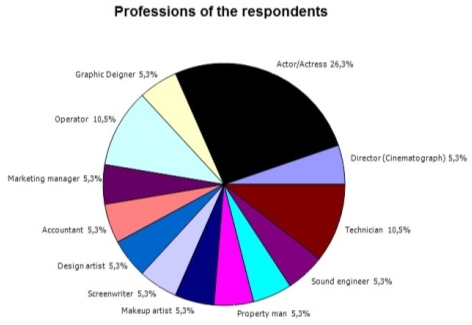
Figure.1 obtained from the QDA miner software
According to the interview with the director of the company, Sultankhodjaev (2016), the number of employees depends on a project. For example for a film, the company may have 30 people, whilst for a short video about 15 employees may be involved. Moreover, according to the conducted observations, the number of employees during the process of film shooting was volatile. For the first observation, Lola’s musical video, twenty people were employed (a singer; 12 actors (2 for the main roles); a stage director, a cinematographer, an operator; a property-man; a make-up artist, a costume designer; and a decorator). The idea of the project was about warfare, which was held at the botanical garden (see video appendix: Lola – filming process). Thus, 14 different actors were involved in the shooting of the film that composes most of the employees. However, during the second observation, which was Jasur Umirov’s project, there were 38 people involved. The number of employees had increased due to the dancing scenery that consisted of 20 dancers. As for the last observation, only eight people participated in the filming process (see video appendix: Jasur Umirov – Nima qilay).
Moreover, the results of the conducted interviews show that 81 percent (17 people) of the staff are employed on a part-time basis. However, an accountant, a sound engineer, a montage director as well as the director of the company are the regular, full-time employees (Figure.2). Hence, the number of people during a filming changes pursuant to the idea of the project.
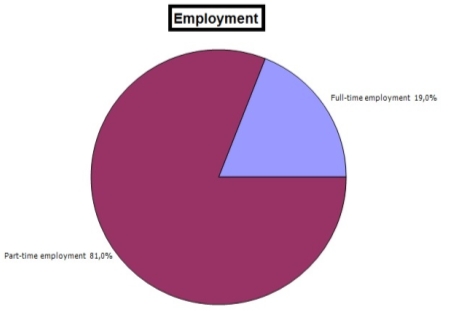
Figure.2 obtained from the QDA miner software
To examine current work-life balance of employees at the company.
The results of this objective will present the detailed data of the existing components of work-life balance; the factors that positively as well as negatively influence the employees’ performance; and the importance of these factors for the company and its employees. The data, gathered through the data collection instrument, has been analysed in QDA miner software that has provided the analyses of coding frequency and coding co-occurrence.
According to the conducted interviews with the director and the employees of Narimon Film, it was found that the company provides the flexible time policies, set according to the corporate needs (81 percent of part-time employees). Therefore, the research shows that the employees are satisfied with the current work-life balance. The percentage of people satisfied with their working hours is 78.9 percent (see appendix 4). Sultankhodjaev (2016) cites that “almost everybody, who works with me, they are free.” However, during the filming process, the staff spends more than 10 hours to accomplish it. According to the following bar chart, thirteen people including the observer assert that they spend more than 10 hours during the process of film shooting and only four people allocate 3 hours of their time for the project (Figure.3). In addition, the respondents assert that sometimes a project with a difficult idea can be performed during two days besides the editing process. Bakhodirov (2016), the editor and graphic designer, state that the editing process may need a month to be completed.
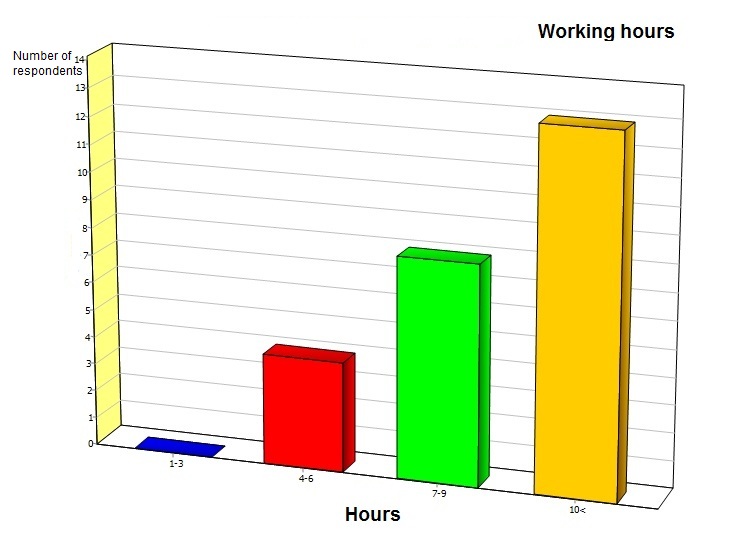
Figure.3 obtained from the QDA miner software
Furthermore, the company provides such employee entertainment programs as internal corporate events: weddings, concerts and social evenings. Khurshid (2016) cites the “we always go somewhere together. Weddings, parties, concerts and so on.” During these corporate events, any employee of Narimon Film Company may be engaged. The program is aimed to increase the level of employees’ productivity through raising the interest in film industry. However, the organization does not provide such work-life balance programs as employee assistance plans (child-care support); health promotion initiatives (sick leaves) and other employee support programs. In spite of that, the respondents stated that the company afforded vocations and sick leaves related to the health or personal issues.
The data received from the conducted interviews and analysed through QDA miner software presents the clear results of the current work-life balance factors that positively influence the companies’ as well as employees’ performance. According to the research, such factors as sleep/rest, physiological (harmony, satisfaction, self-esteem, interest and happiness), motivation, family, mood as well as flexibility factors have been mentioned by the respondents. The interviewees did not have options to choose, answering the following questions in order to receive the reliable and valid information: “What factors can influence on the quality of you performance?”, “How the balance between work and personal hours increase your performance at the company?” and “Do long working hours influence your productivity? How?”. The results of QDA miner have indicated that the most significant factors of the current work-life balance that positively effect the performance of employees are the physiological factors (Figure.4). The respondents note that harmony, satisfaction, self-esteem, interest and happiness at work are the main reasons to raise the self-performance (12 people). Moreover, the director as well as the employees affirm that proper rest, financial motivations, and positive events in families can increase the quality of a final project. For example, the project can be more “beautiful” in terms of montage and graphics (Bakhodirov, 2016). Additionally, the actors may perform better if they have interest in a role they are performing, the rest during the process and motivation in the form of financial incentives.
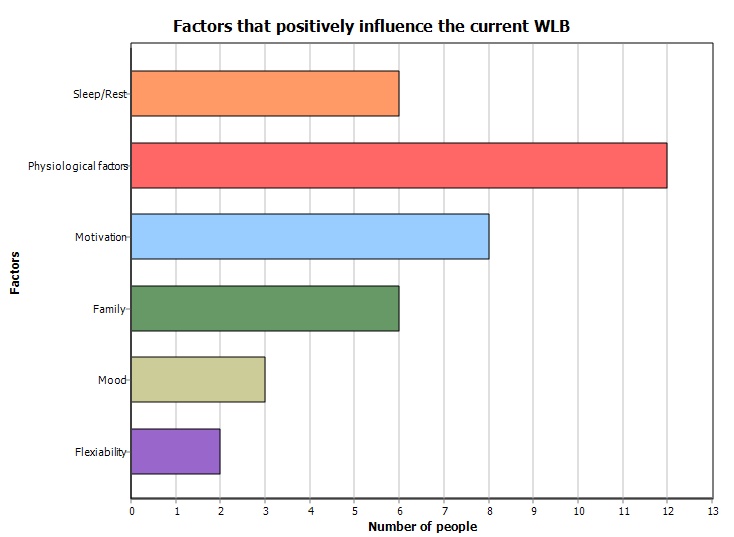
Figure.4 obtained from the QDA miner software
Moreover, Sorensen’s coefficient, the statistic illustrating the similarities, presents the agglomeration order of the positive factors mentioned by the respondents (figure 5). As it is clearly seen from the graph below (known as a tree graph), that such work-life balance factors as motivation, physiological and sleep/rest are combined together, which means that the codes tend to appear together in most of the cases. For example, the accountant of the company, Larisa (2016) states that the “long working hours, leisure, sleep, harmony and of course money” may positively influence the quality of her performance. Whilst, the other factors of work-life balance (family, mood and flexibility) are independent and appear separately in the remaining cases.

Figure.5 obtained from the QDA miner software
As concerns the negative factors affecting the performance of the employees, the respondents have mentioned 10 items (figure 6). In concordance with the figure below, the most influential factors are health (10 people), stress (9 people) and family (7 people). The director of Narimon Film, affirms that sometimes a filming process, ‘first of all’, affects the health of an employee, that further, reflects on his/her quality of your work.. Additionally, Bakhodirov (2016) adds that in case of the montage process, the eyesight as well as the eye fatigue problems may occur because of the long working hours at the computer. Hence, it may negatively affect the attentiveness, creativeness as well as the quality of work, in general. Moreover, the factors as tiredness and difficulty have also the negative impact on the employees’ performance, as it was noticed during the company observations. For example, the physical tiredness that may cause muscular pains as well as the difficulty of an idea, the shooting an episode in the mountains (see video appendix: Anvar Sanaev – Oh dedim)
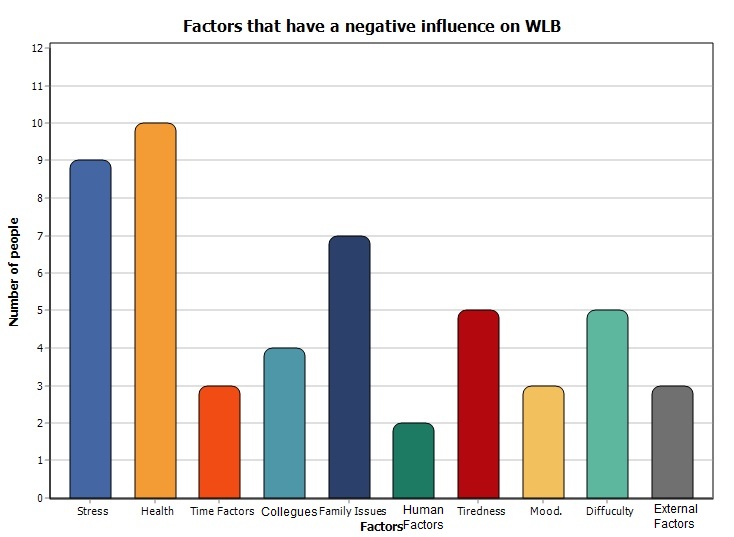
Figure.6 obtained from the QDA miner software
Furthermore, it was found that the stress, health as well as the family factors are interrelated at Narimon Film Company (figure 7). The director and the sound engineer of the company have distinguished the factors and mentioned that the issues related to their families as well as the stress may cause health problems or in another case, the stress at work may lead to “loss of the family” (Sultankhodjaev, 2016). Additionally, the interrelation of the health, stress and family factors with the others such as mood and tiredness have occurred during the interviews. Consequently, the combination of these factors may significantly influence the performance of the employees at the company.
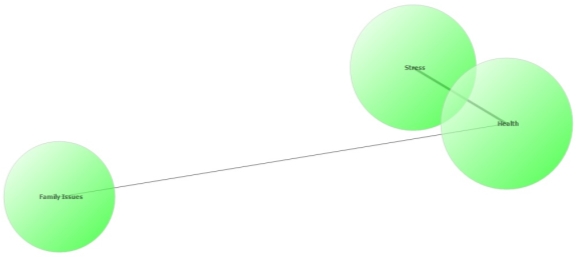

Figure.7 obtained from the QDA miner software
The following tables have been created in order to clearly present the positive and the negative factors that each employee value at the workplace. It can be seen that the actor is mostly affected by the stress factor during the process of filming. However, the motivation in the form of money can positively influence the actor’s performance. Whilst, the director distinguished such work-life balance factors as stress, health, family, tiredness and human character (humanness). Sultankhodjaev (2016) asserts that the long working hours may cause tiredness, stress and health issues. For example, sometimes a film has to be taken during one day from the morning until the night, in poor conditions (cold or hot weather) that may cause such health issues as influenza and neuralgia. During the second observation, the dancers, actors, singers as well as the observer acted in cold weather dressed in suits and dresses. By the end of a day, the temperature fell to +1 degree on Celsius.
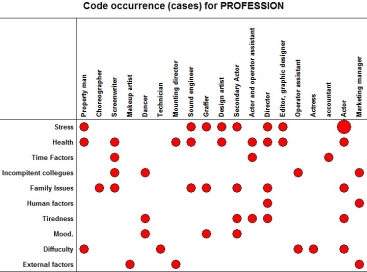
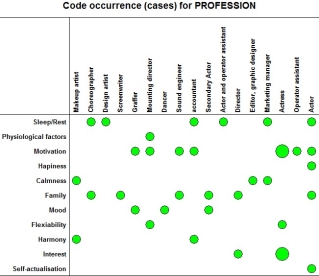
Figure.8 obtained from the QDA miner software
To identify and analyze the major Key Performance Indicators of employees’ productivity at Narimon Film Company
The interviews as well as the observations have helped to identify the Key Performance Indicators of the company. Sultankhodjaev (2016) asserts that the Key Performance Indicators of the film projects are time assignation, technology exploitation and budget allocation.
Long-term projects may allow the producers to create an interesting idea for a project; the editors to utilize more visual effects; the equipment technicians to select the most appropriate cameras, lenses and tripods. The technologies such as a camera and its accessories, microphones, audio mixers as well as illumination equipment provide a high-quality video, a high dimensional picture and other technical specifications. However, the budget is the main indicator that helps the company to achieve the highest quality of a film project.
Sultankhodjaev (2016) cites that “everything depends on budget”, the budget may help to hire the most popular actors and dancers as well as rent the modern equipment. While, the employees of the company state that time factor is the most important Key Performance Indicator for the quality of a film production (figure 9).
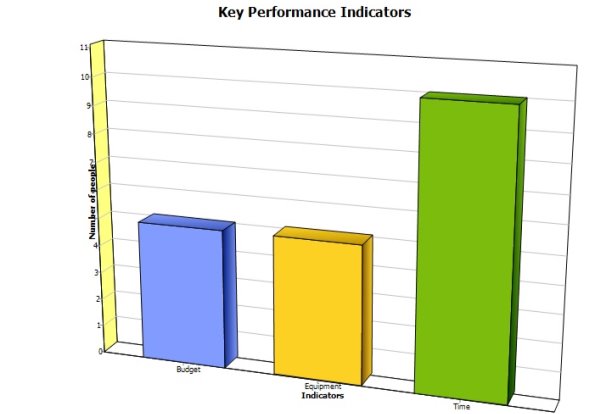
Figure.9 obtained from the QDA miner software
The results of the interviews show that the Key Performance Indicators of the employees’ performance are creativity, time-management, job skills and teamwork.
The creativity at Narimon Film Company is the most important indicator of the performance of an employee. It has been manifested in such specialists as the director, actor, design artist, screenwriter, make-up artist, choreographer, dancer, sound engineer and montage director (9 people). The creativity during the filming and editing processes is a significant attribute. It may help to develop a unique idea for a project, create a subtle style of the montage and build a recognizable feature for the company.
The time-management is a crucial performance indicator of the employees as well as the entire company. The personnel has to manage the time by planning a day, following the schedules and being responsible for the deadlines. Sultankhodjaev (2016) affirms that it is important that the current employees are trying to be punctual, being late only for 15-20 minutes to accomplish a task. Hence, according to the research seven people has a proper time-management. Additionally, during the observation, the musical-movie of Jasur Umirov has taken 12 hours. The time-management was planned and the staff has met the goal performing the filming until the evening.
Furthermore, it was found that 12 people out of 21 respondents have shown their job skills. This performance indicator is based on the knowledge and experience of the employees of acting during the process, using the equipment and working with the montage software. The outcome of the second observation showed the poor job skills of the singer that influenced the time of the project. Jasur Umirov had poor dancing skills that caused to take the doubles (re-shooting the episode in the film). It also created the insignificant difficulties during the montage process.
The next Key Performance Indicator, that has been identified is teamwork skill. The results indicated eight people with team working skills (the gaffer, choreographer, two operator assistants, and four actors). The teamwork is important for the mentioned occupations. The operators as well as the actors have to work jointly in order to increase the understanding and performing levels that will reflect on the quality of work.
To identify influence between work-life balance of employees and their productivity at work
The following paragraph will present the influence between the work-life balance factors and the Key Performance Indicators of the personnel.
The data have been analysed through QDA miner software based on the transcripts of the interviews that helped to develop the coding sequences, coding by variable and Chi-square test analyses for this objective. The variables contain excel as well as word documents and include the numerical values. There are seven main variables such as profession, work performance, gender and KPIs (creativity, time management, teamwork and job-skills). The variables of KPIs have been created separately for the clear analyses. The KPIs’ variables are consist of numerical data (1 and 2). Thus, 1 states for ‘yes’ to confirm the KPI in a case and 2 states for ‘no’ to reject. As concerns the coding, the multiple codes has been created under the two categories: positive factors and negative factors. These categories list the main positive and negative factors of the work-life balance.
Analyzing, both positive as well as negative factors of the work-life balance, co-occurrence statistics have been developed. The tool has been applied with the aim to investigate the potential relationships between the codes within the document by indicating the proximity or the co-occurrence of the developed codes. The following statistics below presents the co-occurrence of the positive and negative factors of the current work-life balance (figure 10). It is clearly seen that the co-occurrence of health and stress factors is 6, which means that these codes (health and stress) have appeared in the six cases of the research. In other words, 30 percent of the respondents assert that health and stress issues are the main causes of poor productivity within the company. Whilst, other employees think that family is the main reason of low productivity (6 cases). They note that the issues related to their families may have the influence on the other factors as stress, mood and health. Nevertheless, the family is also a factor of a positive influence that may increase the interest and motivation of an employee to work more efficiently.
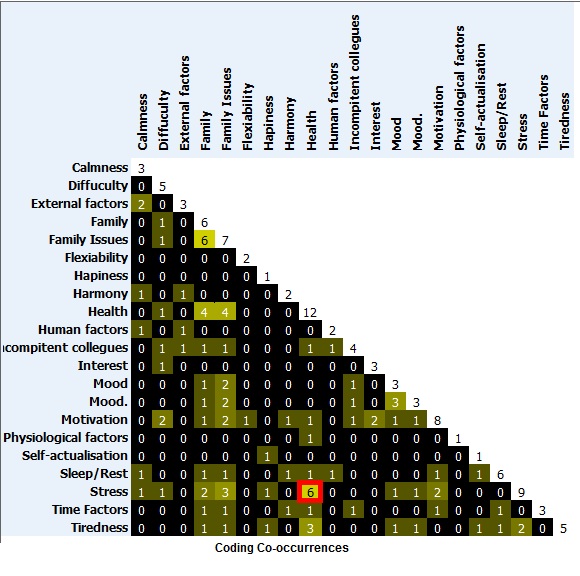
Figure.10 obtained from the QDA miner software
The following paragraphs indicate the results of Chi-square test that has been developed with the help of QDA miner. The ‘coding by variable’ analyses have provided the comparison of the numeric data of the KPIs. As it was mentioned above, the KPI variables have been created separately with 1 and 2 numeric data (‘yes’ to confirm and ‘no’ to reject the KPI).
The first Chi-square statistics has been developed according to the KPI variables and the factors that positively influence the work-life balance. Each of the variables have been tested with the codes in the software. The results have indicated the relationship of the codes with the creativity variable. As it can be seen below, the P-value of the relationship between family factor and creativity (KPI) is 0.023 (figure 11), which means that there is a significant relationship between the code and the variable (>0.05 – there is a relationship). The results show that the positive events in the family (weddings, birth of a child and other family celebrations) of the employees may significantly influence their creativity at work. Sultankhodjaev (2016) cites that “… the family is like ‘Vatan’, a homeland. If there is something happening in your family, you cannot work.”
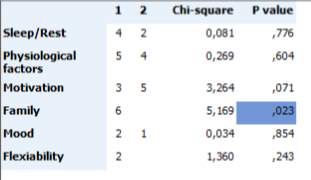
Figure.11 Chi-Square, obtained from the QDA miner software
Furthermore, all the codes that negatively influence the work-life balance have been analysed with the existing variables in order to retrieve the relationships between codes and all the variables: creativity, time-management, teamwork as well as job skills. According to the next two statistics below, the relationships of the codes between the variables as time-management and creativity has been determined.
The P-value relationship of the ‘incompetent colleagues’ factor and time management KPI variable is 0.049, which states that the time management of the employees at Narimon Film depends on the incompetent colleagues (figure 12). This can include lack of skills of the employees as well as the management issues and communication problems at the company. For instance, during the observation 1 and 3, it was found that the poor skills of the actors extended the time of the process.
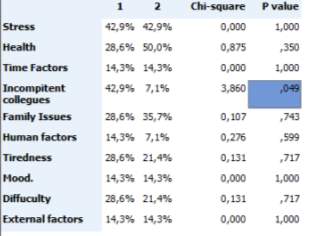
Figure.12 Chi-Square, obtained from the QDA miner software
The last Chi-square test indicates the results related to the creativity performance of the staff. As it is clearly seen from the following table, such a negative factor of the work-life balance as the difficulty of an idea for a film project may significantly influence the employees’ productivity (figure 12). The P-value of the relationship between difficulty of an idea and creativity of employees has a high index, 0.027 (the smaller the value, the higher ratio). For example, the idea of the musical-movie called ‘Sahzoda – Chicco’ was consisted in creativity of the artist. Additionally, 75 percent of the project was based on the artists’ work (see video appendix: Shazoda – Chicco, a working process). The producer has rejected the first pictures of ‘Chicco’ presented by the artists that led to re-execute the task.
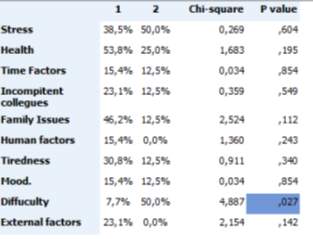
Figure.13 Chi-Square, obtained from the QDA miner software
Conclusion
The following chapter is based on the interpretation of the results mentioned above with respect to the developed objectives and research question. It should be noted that some of the findings correspond to the ones that have been mentioned in the literature review part. However, during the analyses of the data obtained from the research, it was found that some of the findings are different from the results presented by the previous scholars. The findings of the research may be considered as valid and reliable due to the several company observations, semi-structured interviews and clear results generated by the software, QDA miner. The observations have been conducted three times in order to measure the work-life balance in the several projects. As for the interview research, the structure of the interview allowed to paraphrase and ask the additional questions for the clear understanding the concept of the research. In addition, QDA miner software has assisted with the data analyses providing the precise charts, tables and statistics.
First, it was mentioned that the film production process is a challenging industry. As Royster and Vilorio (2013) have stated, that the industry consist of long working hours and stress. These factors have been occurred during the observations. According to the observational notes (see appendix 1), the filming processes occupied at least 10 hours. Whilst, the most difficult one lasted for 14 hours (see video appendix: Lola – filming process). Moreover, the interview results showed that thirteen respondents affirmed that they spend at least 10 hours during a filming process (figure 3). Indeed, a 3 minute-video production may take more than 12 hours and in average 1 month to edit it. With accordance to the research findings, it may be confirmed that the film industry requires a lot of effort and long hours of work from the staff at Narimon Film Company. Furthermore, Royster and Vilorio (2013) have asserted that stress may occur because of inflexible deadlines. Hence, stress at the workplace is the main factor of the work-life balance that affect the employees’ performance (Bickford, 2015). However, the results obtained from the figure 6 and 7 have indicated that the main factors influencing negatively the performance of the personnel at Narimon Film are health problems, stress and family issues. While, inflexibility factors have not been considered as the major ones. During Jasur Umirov musical movie process, the weather temperature was +10 during a day and fell to +1 by the evening that led to the observer and the director to the disease of influenza (see appendix 5).
In spite of this, other authors have indicated the family factor as the most significant one (Googins, 1991; Frone et al., 1997; Burke, 1988 cited in Grant-Vallone and Donaldson, 2001). They state that the poor work-life balance may lead to work-family conflict that is based on time-, involvement and satisfaction-balances. According to the findings from the interviews, family factor is also significant in work-life balance of the company. As it was mentioned above, the family issues are interrelated with stress and health. Hence, such interrelations may lead to absenteeism from work or dismissal of an employee. However, the family factor may also positively influence the employee’s performance at work. For example, positive events in employee’s family life may decrease his/her stress level at work and be fully involved to the work process. The director of the company, Sultankhodjaev (2016) notes that he sometimes involves his family member for film shootings in order to demonstrate them the complexity of the film industry. For instance, in the video of Munisa Rizayeva, his son can be seen in the several episodes (see video appendix: Munisa Rizayeva – Man bop). It can be a useful strategy for the development of the current work-life balance. This may solve the misunderstandings between an employee and his/her family. Finally, it may be stated that such factors as health, stress and family are frequent at Narimon Film Company. These distinctions between the studies may be related to the differences of film standards at Narimon Film Company. The company is not large and mainly it is engaged in short musical movies with the duration of 3-4 minutes.
Furthermore, the scholars have recommend the various work-life balance programs, which may auspiciously reflect the employee’s productivity (AWLP, 2011; Rantanen at al., 2011 and AEC, 2007). Revealing the results, it can be seen that Narimon Film Company follows the mentioned programs and provides social entertainment programs by organizing informal social evenings with its employees. Additionally, the company provides vacations and sick leaves to the employees, who needs them due to the clear reasons. However, it does not afford such employee assistant programs as child care support and maternity leaves. The main reason is that the company based on the part-time employment.
Moreover, Davidson (2014) has mentioned six main components of work-life balance such as self-, time-, stress-, change-, technology- and leisure- management types in order to achieve the successful balance between work and life. Additionally, the scholars assert that a person has to have such physiological requirements as sufficient sleep and rest from work, as well as comfort and gratification at the workplace that will help to be productive and efficient (Fagan et al., 2011 and Tremblay, 2012). In case of Narimon Film Company, it was found that the company does not provide the mentioned requirement due to the part-time employment (80 percent are part-time workers). The main reason is that a filming process does not require everyday activities, the film shooting takes one or two days, where the employees spend at least 10 hours. Further, after the film shooting, it transfers to the editing process that may take a month. Moreover, the results of the interview have presented that the majority of the staff members are satisfied with their current work-life balance (see appendix 4). The respondents note that they have a flexible schedule, that allows spending time to study, family and other additional work. Most of them are freelancers and have the own business (Sultankhodjaev, 2016). For example, the montage director, the respondent of the interview, is a founder and director of Fox Music Cinema Company. Consequently, considering that the company mostly consists of part-time employees, it does not provide rest as well as comfort activities at the workplace. However, the results from the conducted interviews show that sleep and rest factors would positively influence the employees’ performance that may reflect to the project performance. According to the information above, the company needs to provide the breaks for the employees to eat, warm and communicate.
Taking into consideration the primary as well as the secondary research, it was found that the Key Performance Indicators in the film industry are time, technology and budget. Sultankhodjaev (2016) cites that “the deadline is time, money of course, quality”. The deadlines of the projects play a crucial role in the film production business. The company is responsible for punctuality of a project. These responsibilities lie on such employees as (Telefilm Canada, 2012):
Profession Responsibilities
Producers and directors – to engage the right employees to the project, to develop a filming schedule, to keep a film on budget;
Cinematographers – to lead and control the operators, to choose an appropriate frame and right equipment;
Editors – to use appropriate raw materials for the montage; to colour the project; to utilize right computer effects
Costume designers – to find a suitable design; to develop a film’s wardrobe; to control the style of the actors during the process;
The non-fulfillment of the job duties may lead to the fail of the project. For instance, the wrong idea of the project has led to the fact that the film project could not get to the TV screens, public channels. Therefore, a song of Jalil Mavlonov called ‘Malikam’ has two musical videos of the same song. The first version has been prohibited by the Department of TV and radio of Uzbekistan because the idea was related to ‘the unhappy love’ of the deaf-mute person. As a consequence, the film company had to retake the episode of the video.
As regards technologies, they assist the operators and editors to perform their work better. Such equipment as cameras, lenses, tripods as well as illumination equipment provide the opportunities to realize creative ideas of the operator. For example, the ‘RED’ camera, the most popular one in the film industry, may provide the opportunity to apply the function of the camera called rapid (slow motion), that helps to switch between normal and low-speed shooting.
The next KPI of the film industry is budget. “Everything depends on budget” in the film industry (Sultankhodjaev, 2016). Having the high budget, the producer may hire the best actors, take a film abroad as well as involve the best equipment and operators. For example, the significant difference between the budgets of the musical video can be seen from the observation 1 and 3 (see video appendix: MCCW). Also, the project called ‘Shohruxhon – Nima qilish kerak’ became popular due to the budget that allowed the film crew to take the video in Malaysia and rent the helicopter for the film shooting.
Moreover, according to the research, four main KPIs of the respondents have been determined: creativity, time management, job skills and teamwork.
The company applies interesting and creative ideas to the projects. This helped the company to win the award for best video of the year in 2011. The company has received the award due to the creative idea of the graphic designer. The graphic designer has used visual effects, which have not been employed by other graphic designers in Uzbekistan. Moreover, the uniqueness and creativity of the talented artist can be noticed in the musical video called ‘Chicco’ by Shahzoda (see video appendix: Shahzoda – Chicco, a working process). The project has claimed the nomination of the best song and the best video of 2013. It became the most popular and recognizable among the Uzbek population. The mentioned achievements of the company significantly depend on the employees’ creativity. Furthermore, the results of Chi-square test show that the creativity performance depends on several work-life balance factors, such as family and difficulty of idea.
The stability at the family provides a person the sense of harmony and satisfaction at work. Additionally, the levels of stress, depression and irritability are decreasing due to the family happiness. The low levels of these factors impact on the employees’ performance during work (Rantanen et al., 2011; Fapohunda, 2014; Sivatte et al., 2015). The study of the primary research have confirmed the researchers’ results that family may influence the productivity and indicated that family, especially, effects the employees’ creativity. Sultankhodjaev (2016) asserts that support as well as understanding are the main factors of the family stability. The strategy followed by Sultankhodjaev can be considered as successful for building the relations between the family and work (engaging family members and demonstrating them the work difficulties). The strategy may also have a positive influence on the creativity. The creativeness may occur during the communication with the family members about the project ideas. The person may receive the suggestions and comments about the idea. For example, the musical movie of Aziz Rajabiy, called ‘Orzularim’ is related to the personal life of the director, Narimon Sultankhodjaev. There, Sultankhodjaev has showed his personal life related to his family. He has presented the idea in a comedy style that made it creative. Moreover, the challenge of the idea and the difficulties related to the implementation of the idea may lead to the fail of reaching the creativity. The idea may not be possible to implement due to lack of experience of the operators, skills of the actors as well as lack of technologies, time or budget. At this point, the KPIs of the company may be met with the KPIs of the employees and affect the creativity. Hence, the difficulties related to the budget, technologies and time also have relationship with creativity.
Besides the creativity, the work-life balance factors have the relationships with the time-management of an employee. The results illustrate that the time management is related with the communication with colleagues during the process (‘incompetent colleagues’ factor). The poor communication as well as misunderstanding are the main causes of long working hours at Narimon Film Company. The example with Jasur Umirov clearly showed the relationships between the factor and the KPI. Lack of dancing skills has led to the extension of the process for one hour. The observations has also showed the poor dancing skills were related to the shyness of the singer. Consequently, it may be considered that such social entertainment programs, mentioned above, may have a positive influence on the shyness so that the person can overcome the barriers and perform better, demonstrating the high productivity level.
As for the other KPIs such as: job skills and teamwork, no relationships have been found. These KPIs are also significant for the film industry. The employees, who have a strong interaction with the coworkers, are the good leaders and decision makers that is important for any organization (Telefilm Canada, 2012). Considering job skills, it is clear that an employee with the professional job skill shows the positive productivity results. However, for the director of the company it is insignificantly important, Sultankhodjaev (2016) states that humanness is the most important than professionalism, the director cites that “if he does not have humanness, and even if he is a genius, professional, I would not work with him”. Thus, it may be related to the past experience of the director, he faced some difficulties related to the their irresponsibility.
Finally, coming to the impact of work-life balance and productivity it can be considered that in general the current work-life balance has the insignificant affect on the employee’s productivity. As it was mentioned above, the most significant factors are health, stress and family. Moreover, it was determined that such Key Performance Indicators as creativity and time-management are mostly influenced by the family, difficulty as well as communication factors. Considering the director, he has created an effective strategy for solving the issues related to the family problems. Moreover, the right direction of social entertainment programs may also change the current situation with creativity performance factor. Additionally, the represented results of the positive factors that have influence the work-life balance may also effect the development of productivity in Narimon Film Company.
Final Chapter
To sum up it can be considered that the research was successfully conducted due to that all the objectives have been discussed and the research question has been answered. However, not all the points of the plan have been reached because of some limitations during the process. In addition, the recommendations and feedbacks provided by the supervisor while the research process.
Probably, the recommendations based on the results and analyses will be implemented by the company. The company has requested the copy of the results in order to solve the current issues the productivity of some employees.
Moreover, the research may be useful for the companies operating in the film industry in Uzbekistan. The company called Fox Music Cinema also was interested in the results from the conducted research. The company is operating in the same field as Narimon Film concentrating only on wedding ceremonies. Thus, the company can implement the same recommendation as well.
Furthermore, the results of primary as well as secondary research about the factors influencing work-life balance may be informative for small companies operating in Uzbekistan. However, the recommendations may be inappropriate for a company.
Recommendations
According to the findings, two recommendations have been developed, corresponding the company:
- First, in order to increase the creativity level of employees the company has to redirect the informal social entertainment programs. The company applies the programs being unaware of being deceived about their consequences. The director states that the programs help to create close relations with the employees. This program may be considered as a significant tool that allows building a positive communication between the colleagues. The company has to redirect the program studying the communication issues of employees. The particular employees as actors, operators and editors have to be required to join the program. They have to find ‘a common language’ that will help to overcome the barriers of effective communication at work. This implementation of work-life balance program may help the company to raise the performance level of creativity.
- Next, considering the effective outcome from the strategy followed by the director, the employees of the company may use the strategy as well. The company has to allow the participation of family members for a film project as a third plan actors or visitors. The strategy will help to build the positive relationships between an employee and his/her family. The strategy will reflect on productivity (time-management and creativity) of the employees. For example, the employees will try to perform better by demonstrating their talents for family members.
Limitations
The study has successfully reached the answer to the research question. However, there were several limitations raised during the research processes:
It was difficult to reach the respondents because of the following issue. The employees are in a part-time basis that have created the difficulties to reach at the office. Hence, the director has provided the personal telephone numbers of the employees in order to meet them and conduct the interview. The respondents have been informed about the interview and its aim. Consequently, thirty percent of the respondents participated the interview during the face-to-face meetings appointed in public places and at their apartments
Time, for the project has limited the observer to conduct the research for the whole film industry in order to get more reliable and valid data that can be applied for the whole industry and generalized for the other film production companies.
Implications for further research
As it was mentioned above, the study could be done for the entire film industry. The study could cover all the companies operating in the film industry in Uzbekistan, particularly in Tashkent that would help to reveal most of the problems with work-life balance and productivity of employees. Moreover, the results could be more beneficial for Narimon Film Company and its employees.
Bibliography
ACAS. (2015). Flexible working and work-life balance. Available from http://www.acas.org.uk/media/pdf/j/m/Flexible-working-and-work-life-balance.pdf [Accessed 28 January 2016].
Alliance for Work-Life Progress. (2011). Seven Categories of Work-Life Effectiveness. Available from www.awlp.org/pub/work-life_categories.pdf [Accessed 18 December 2015]
Arizona Employers’ Council, Inc. (2004). Flextime and Compressed Workweeks. Available from: http://www.valleymetro.org/images/uploads/rideshare_documents/SAMPLE_Flextime_and_Compressed_Workweeks_Guidance.doc [Accessed 05 February 2016]
Bell, A., Rajendran, D. and Theiler, S. (2012). Job Stress, Wellbeing, Work-Life Balance and Work-Life Conflict Among Australian Academics. Electronic Journal of Applied Psychology, 8 (1), 25-37. Available from www.sensoria.swinburne.edu.au/index.php/sensoria/article/viewFile/320/316 [Accessed 17 December 2015].
Bendriss, A. (2012). QDA Miner – Qualitative Data Analysis Software for Qualitative Research. YouTube. Available from https://www.youtube.com/watch?v=zYKxGSqQ1pY [Accessed 30 March 2015].
Bickford, M. (2005). Stress in the Workplace: A General Overview of the Causes, the Effects, and the Solutions. Canadian Mental Health Association. Available from http://www.cmhanl.ca/pdf/Work%20Place%20Stress.pdf [Accessed 28 March 2016].
Bird, J. (2006). Work-life balance: Doing it right and avoiding the pitfalls. Employment Relations Today, 33 (3), 1-9. Available from http://www.worklifebalance.com/assets/pdfs/article3.pdf [Accessed 17 March 2016].
Bloom, N. et al. (2006). Work-life balance, management practices and productivity. Centre for Economic Performance. The London School of Economics and Political Science. Available from http://cep.lse.ac.uk/management/worklifebalance_research.pdf> [Accessed 21 March 2016].
Bradley, L. et al. (2006). Talking the talk and walking the walk. International Journal of Managing Projects in Business, 3 (4), 589-603. Available from www.dx.doi.org/10.1108/17538371011076064 [Accessed 17 November 2015].
Bradley, L. et al. (2010). Clients driving construction innovation. England: Pearson Education Limited. Available from www.eprints.qut.edu.au/8128/1/8128.pdf [Accessed 15 November 2015].
Centers for Disease Control and Prevention. (2008). Evaluation Briefs. Data Collection Methods for Program Evaluation: Observation, 16 1-2. Available from www.cdc.gov/healthyyouth/evaluation/pdf/brief16.pdf [Accessed 15 February 2016].
Dessanayaka, N.M.N.P. and Hussain Ali, M.A.M. (2013). Impact of work-life balance on employees performance: An Empirical Study on Seven Apparel Organizations in Sri Lanka. 60-64. Available from www.seu.ac.lk/researchandpublications/symposium/international/2013/Management/Impact%20of%20worklife%20balance%20on.pdf [Accessed 17 November 2015].
Doherty, L. and Manfredi, S. (2006). Action research to develop work-life balance in a UK university. Women in Management Review, 21 (3), 241-259. Available from www.dx.doi.org/10.1108/09649420610657416 [Accessed 17 November 2015].
Dudovskiy, J. (2016). Inductive Approach. Available from http://research-methodology.net/research-methodology/research-approach/inductive-approach-2/ [Accessed 28 March 2016].
Eck, D., and Ryan, J.. (no date). Chi Squre Test. Available from math.hws.edu/javamath/ryan/ChiSquare.html [Accessed 28 December 2015].
Eikhof, C., et al. (2007). Introduction: What work? What life? What balance?. Employee Relations, 29 (4), 325-333. Available from www.dx.doi.org/10.1108/01425450710839452 [Accessed 17 November 2015].
Fagan, C., et al. (2012). The influence of working time arrangements on work-life integration or ‘balance.’ Conditions of Work and Employment Branch, (32), 1-60. Available from http://www.ilo.org/wcmsp5/groups/public/—ed_protect/—protrav/—travail/documents/publication/wcms_187306.pdf [Accessed 15 February 2016].
Fapohunda, M. (2014). An Exploration of the Effects of Work Life Balance on Productivity.(2), 71–89. Available from www.jhrmls.com/journals/jhrmls/Vol_2_ No_2_June_2014/5.pdf [Accessed 15 November 2015].
Freeman, R. and Kathryn, S.(2009). International Differences in the Business Practices and Productivity of Firms. Chicago: The University of Chicago Press. Available from www.nber.org/chapters/c0441 [Accessed 16 November 2015].
Grant-Vallone, E. and Donaldson, S. (2001). Consequences of work-family conflict on employee well-being over time. Taylor and Francis, 15 (3), 529-550. Available from www.cgu.edu/include/Consequences%20of %20work-family%20conflict.pdf [Accessed 15 February 2015].
Greenhaus, H.et al. (2003). The relation between work-family balance and quality of life. Journal of Vocational Behaviour, 63, 510-531. Available from https://www.polyu.edu.hk/mm/jason/doc/Greenhaus-Collins-Shaw%202003%20JVB.pdf [Accessed 15 November 2015].
Hamming, O. and Bauer, G. (2009). Work-life imbalance and mental health among male and female employees in Switzerland. International Journal of Public Health, 54 (2), 88-95. Available from www.link.springer.com/article/10.1007/s00038-009-8031-7 [Accessed 15 November 2015].
Horst, D. (2014). Quality of Working Life and Productivity: An Overview of the Conceptual Framework. International Journal of Managerial Studies and Research (IJMSR), 2 (5), 87-98. Available from https://www.arcjournals.org/pdfs/ijmsr/v2-i5/11.pdf [Accessed 17 March 2016].
Hyman, J. and Summers, J. (2007). Work and life: can employee representation influence balance?. Employee Relations, 29 (4), 367-384. Available from www.dx.doi.org/10.1108/01425450710759208 [Accessed 15 November 2015].
Isamu, Y. and Toshiyuki, M. (2012). Effect of Work-Life Balance Practices on Firm Productivity: Evidence from Japanese firm-level panel data. Available from www.rieti.go.jp/jp/publications/dp/12e079.pdf [Accessed 15 December 2015].
Konrad, A. and Robert, M. (2000). The impact of work-life programs on firm productivity. Strategic Management Journal, 21 (12), 1225-1237. Available from www.onlinelibrary.wiley.com/doi/10.1002/1097-0266(200012)21:12%3C1225::AID-SMJ135%3E3.0.CO;2-3/abstract [Accessed 17 November 2015].
Lewis, S., et al. (2003). Reflections on the integration of paid work and the rest of life. Journal of Managerial Psychology, 18 (8), 824-841. Available from www.dx.doi.org/10.1108/02683940310511908 [Accessed 17 November 2015].
Marshall, C. and Rossman, C. B. (1999). Designing Quantitative Research. 3rd ed. Thousand Oaks, CA: Sage.
McMahon, C. and Pocock, B. (2011). Doing things differently: Case Studies of Work-Life Innovation in Six Australian Workplaces. University of South Australia. Available from http://w3.unisa.edu.au/hawkeinstitute/cwl/documents/case-studies.pdf [Accessed 26 March 2016].
Meghna, V., et al. (2007). “Doing more with less”. Career Development International, 12 (5), 468-480. Available from www.dx.doi.org/10.1108/13620430710773772 [Accessed 16 November 2015].
Mukhtar, F. (2012). Work life balance and job satisfaction among faculty at Iowa State University. Available from lib.dr.iastate.edu/cgi/viewcontent.cgi?article=3798&context=etd [Accessed 17 November 2015].
OSHA-EU. (no date). FAMILY ISSUES AND WORK-LIFE BALANCE. Available from: https://osha.europa.eu/en/tools-and-publications/publications/e-facts/e-fact-57-family-issues-work-life-balance [Accessed 15 February 2016].
Polaris Resarch. (2016). QDA MINER. Available from http://provalisresearch.com/Documents/QDAMiner40.pdf [Accessed 28 March 2016].
Rantanen, J. et al. (2011). Introducing Theoretical Approaches to Work-Life Balance and Testing a New Typology Among Professionals. Available from www.springer.com/978-3-642-16198-8 [Accessed 16 November 2015].
Robson, C. (1993). Real World Research: A Resource for Social Scientists and Practitional-researchers. UK: Oxford Blackwell.
Royster, S. and Vilorio, A. (2013). From script to screen: Careers in film production. Bereau of Labor Statistics. Available from http://www.bls.gov/careeroutlook/2013/summer/art02.pdf [Accessed 16 March 2016].
Sahadi, J. (2015). No. 1 cause of bad work-life balance? Bad bosses.Available from www.money.cnn.com/2015/04/21/pf/work-life-balance/ [Accessed 1 February 2016].
Saunders, M., Lewis, P. and Thornhill, A. (2003). Research Methods for Business Students. 3rd ed. England: Pearson Education Limited.
Sekaran, U., and Bougie, R. (2010). Research Methods for Business. Chichester: A John Wiley and Sons Ltd.
Shankar, T. and Bhatnagar, J. (2010). Work Life Balance, Employee Engagement, Emotional Consonance/Dissonance & Turnover Intention. Indian Journal of Industrial Relations, 46 (1), 74-87. Available from www.jstor.org/stable/25741098 [Accessed 16 November 2015].
Sivatte, I. et al. (2015). The impact of work-life culture on organizational productivity. Personnel Review, 44 (6), 883-905. Available from www.dx.doi.org/10.1108/PR-12-2013-0226 [Accessed 15 November 2015].
Snell, L., et al. (2015). Achieving growth-quality of work life ambidexterity in small firms. Journal of Service Theory and Practice, 25 (5), 529-550. Available from www.dx.doi.org/10.1108/JSTP-04-2014-0064 [Accessed 17 November 2015].
Snieder, R. and Larner, K. (2009). The Art of Being a Scientist: A Guide for Graduate Students and their Mentors, Cambridge: Cambridge University Press.
Stanford HCI Group. (2008). Interviewing and Observing. Stanford HCI. Available from http://hci.stanford.edu/courses/agile/handouts/Interviewing-observing.pdf [Accessed 16 March 2016].
TeleFilm Canada. (2016). Daring to change: DELIVE. 2011-2012 Annual Report. Available from http://www.telefilm.ca/rapport-annuel/2011-2012/pdf/Telefilm_AR12.pdf [Accessed 28 March 2016].
Tremblay, D. (2012). Work-life Balance Encyclopedic Available from www.dictionnaire.enap.ca/dictionnaire/ docs/definitions/definitions_anglais/work_life.pdf [Accessed 17 November 2015].
Tulasidas, M. (2015). Impact of work-life balance on productivity: an investigative study on selected small and medium scale enterprises. Incontinental Journal of Human Resource Research Review, 3 35–47. Available from www.icmrr.org/aug_2015/IJHRRR/20051805.pdf [Accessed 16 November 2015].
University of Connecticut. (2016). Cognitive Access. Available from http://udi.uconn.edu/index.php?q=content/cognitive-access [Accessed 28 March 2016].
Vany, A. and Walls, D. (1999). Uncertainty in the Movie Industry: Does Star Power Reduce the Terror of the Box Office?. Available from http://people.stern.nyu.edu/wgreene/entertainmentandmedia/Devany&Walls.pdf [Accessed 16 March 2016].
White, T., and McBurney, D. (2013). Research Methods. 9th ed. Boston: Wardsworth Cengage Learning.
Wise, S. and Bond, S. (2003). Work-life policy: does it do exactly what it says on the tin?. Women in Management Review, 18 (1/2) 20-31. Available from www.dx.doi.org/10.1108/09649420310462307 [Accessed 17 November 2015].
Young, M, et al. (2013). The business of making movies. Strategic Finance. Available from http://www.imanet.org/docs/default-source/sf/02_08_young-pdf.pdf?sfvrsn=0 [Accessed 16 March 2016].
Appendices
Observation Forms (Appendix 1)
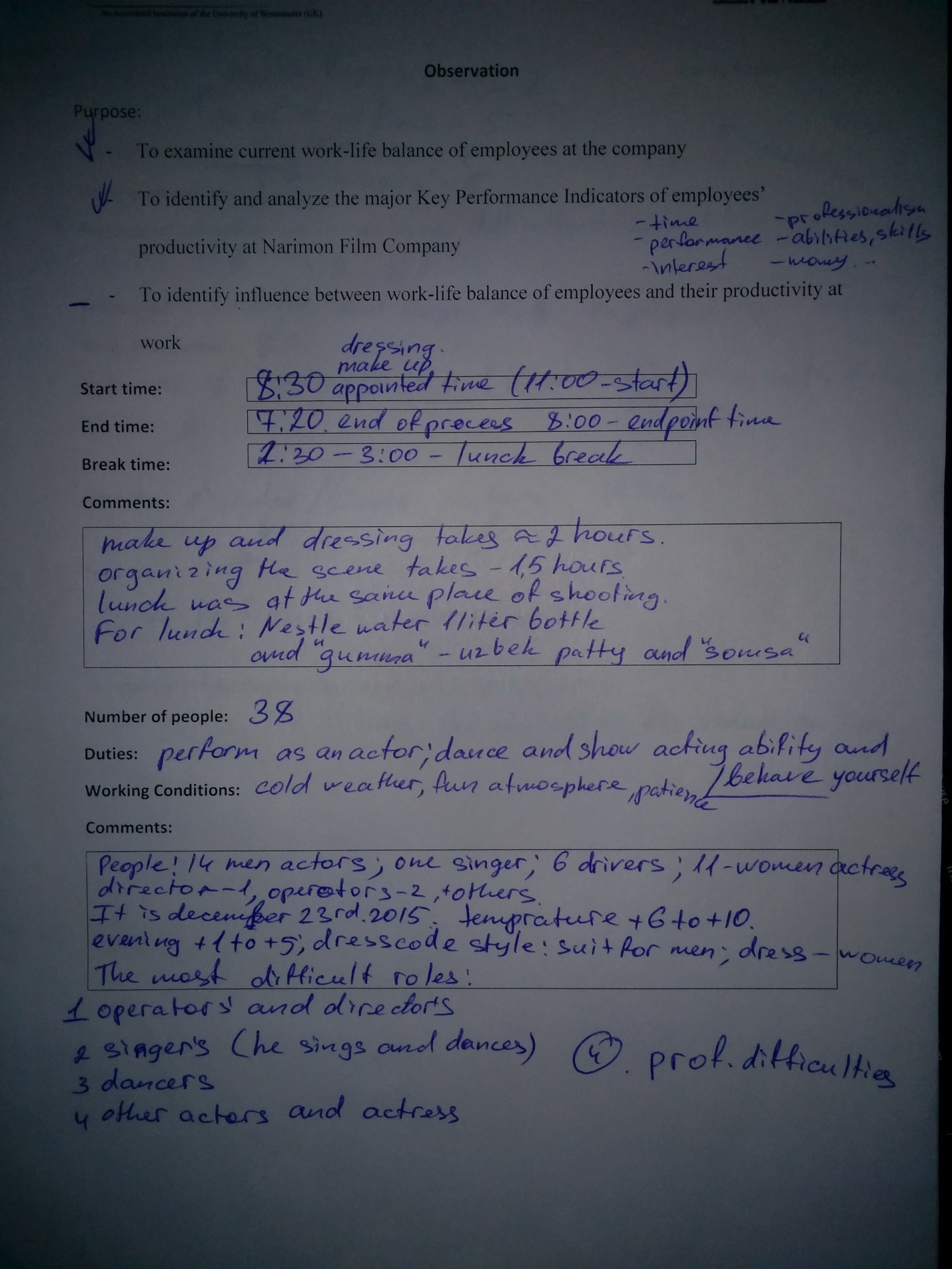
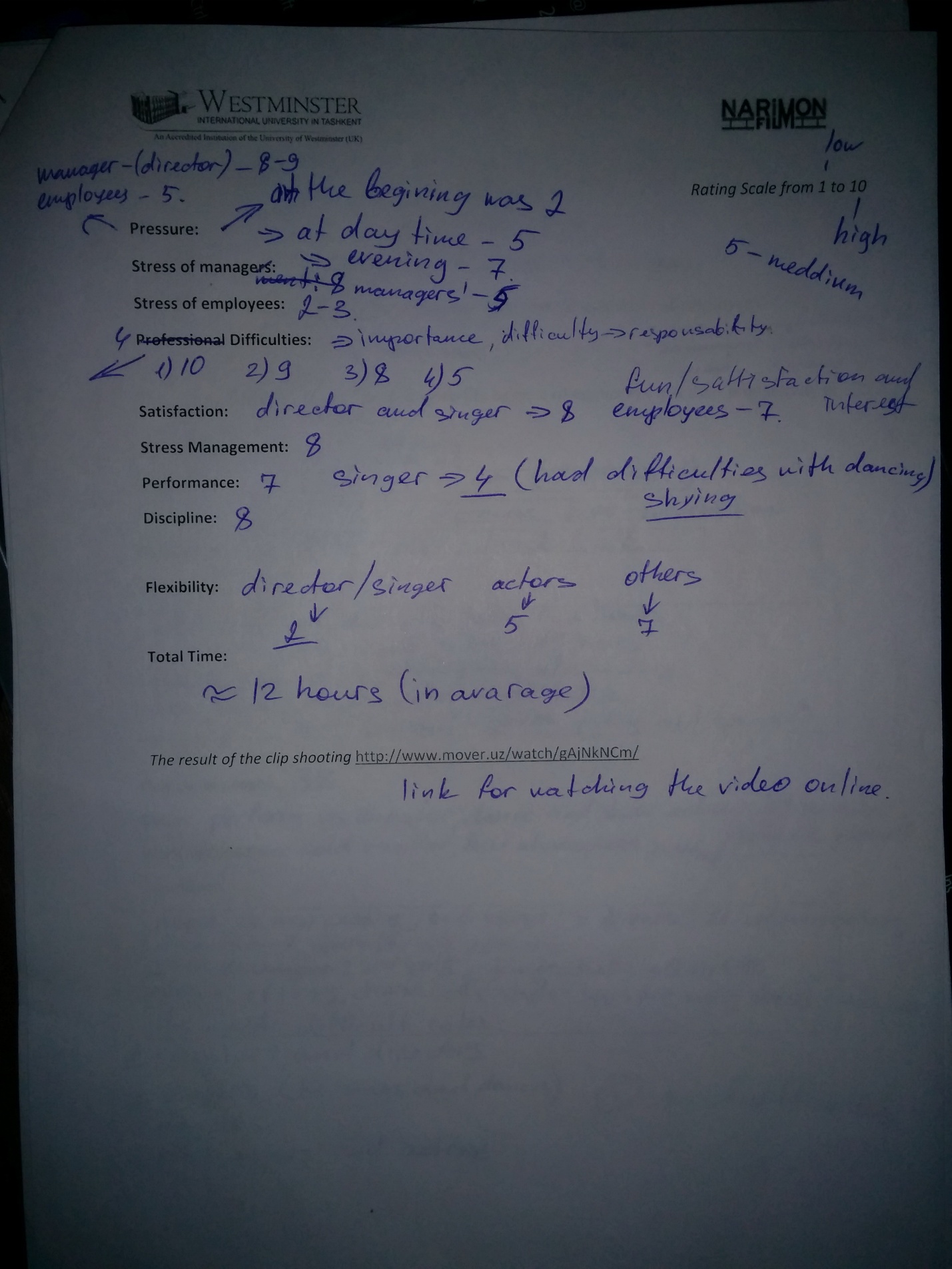
Observation 2 (Jasur Umirov – Nima Qilay)
Purpose:
- To examine current work-life balance of employees at the company●
- To identify and analyze the major Key Performance Indicators of employees’ productivity at Narimon Film Company ●
- To identify influence between work-life balance of employees and their productivity at work
| 8:30 – appointed time, 11:00 start |
Start time:
| 19:20 – end of the process (whole process- 12 Hours) |
| 2:30-3:00 |
End time:
Break time:
Comments:
| Make up and dressing took -2 hours
Organizing the place – 1.5 hours Lunch – was at the same place where was shooting of the movie For lunch – Nestle water, “gumma” and “somsa” |
Number of people: 38
Duties: perform as an actor; dance and show acting ability.
Working Conditions: cold weather, fun atmosphere
Comments:
| People: 14 (men) – actors; one singer; 6 drivers; 11 – (women) actress, director; 2 operators; make up designer and choreographer. Date – 23rd of december 2015, Weather temperature: +6 – +10; evening +1 – +5; dress code style: suite, tie, white shirt, shoes. Women: dress. The most difficult roles: 1. Operator’s and Director’s 2. Singer (he was singing and dancing) 3. Dancers 4. Other actors and actress. |
Rating Scale from 1(the lowest) to 10 (the highest)
Pressure: (pressure was increasing due to cold weather and long time)
At the beginning 2
During the process 5
Evening (at the end) 7
Stress of managers: 5(wondering about the time)
Stress of employees: 2-3
Difficulties:
1. Operator’s and Director’s 10
2. Singer (he was singing and dancing) 9
3. Dancers 8 (physical activities)
4. Other actors and actress. 5
Satisfaction:
Director and singer 8 (reached the goal)
Employees 7 (had fun and money)
Stress Management: 8 (the process was planned and organized)
Performance: 7 but singer’s 4 (the singer had difficulties with dancing and was shying)
Discipline: 8
Flexibility:
Director/singers 2 (no chance to leave the place of shooting)
Actors 5 (had a chance to warm up)
Others 7 (had a chance to warm up)
Total Time: 12 hours (from the begging till the end – coming to the office)
Link to the movie-clip: http://mover.uz/watch/gAjNkNCm/
Observation 3 (MCCW)
Purpose:
- To examine current work-life balance of employees at the company
- To identify and analyze the major Key Performance Indicators of employees’ productivity at Narimon Film Company ●
- To identify influence between work-life balance of employees and their productivity at work
| 11:00 – appointed time, 12:00 start |
Start time:
| 21:00 – end of the process (whole process- 10 Hours) |
| 3:00 – 3:40 |
End time:
Break time:
Comments:
| To take equipment and go to the place 1 hour
Organizing the place – 30 minutes Lunch – at “The Burger” |
Number of people: 8
Duties: perform as an actor; play the main role
Working Conditions: good weather, friendly staff, interesting idea, and common goal.
Comments:
| People: 5 – actors; 1 driver; 2 operators. Date – 15th of march 2015, Weather temperature: +14 – +16; evening +10 – +14; dress code style: casual. The most difficult roles: 1. Operator’s and the main actor’s |
Rating Scale from 1(the lowest) to 10 (the highest)
Pressure: (was increasing but did not too much)
At the beginning 1
During the process 4
Evening (at the end) 5
Stress: 3 (low stress: weather was fine, idea was not difficult)
Difficulties: (the most difficult role was operator’s – he was involved during the whole process)
1. Operator’s 5
4. Others. 3
Satisfaction: 8 (level of excitation was high)
Stress Management: 4 (the process was not organized)
Performance: 6 (had difficulties with dancing)
Discipline: 3 (no discipline)
Flexibility: 8 (the idea was not difficult)
Total Time: 10 hours
Link to the movie-clip: http://mover.uz/watch/05lsVsPm/
Letter (Appendix 2)
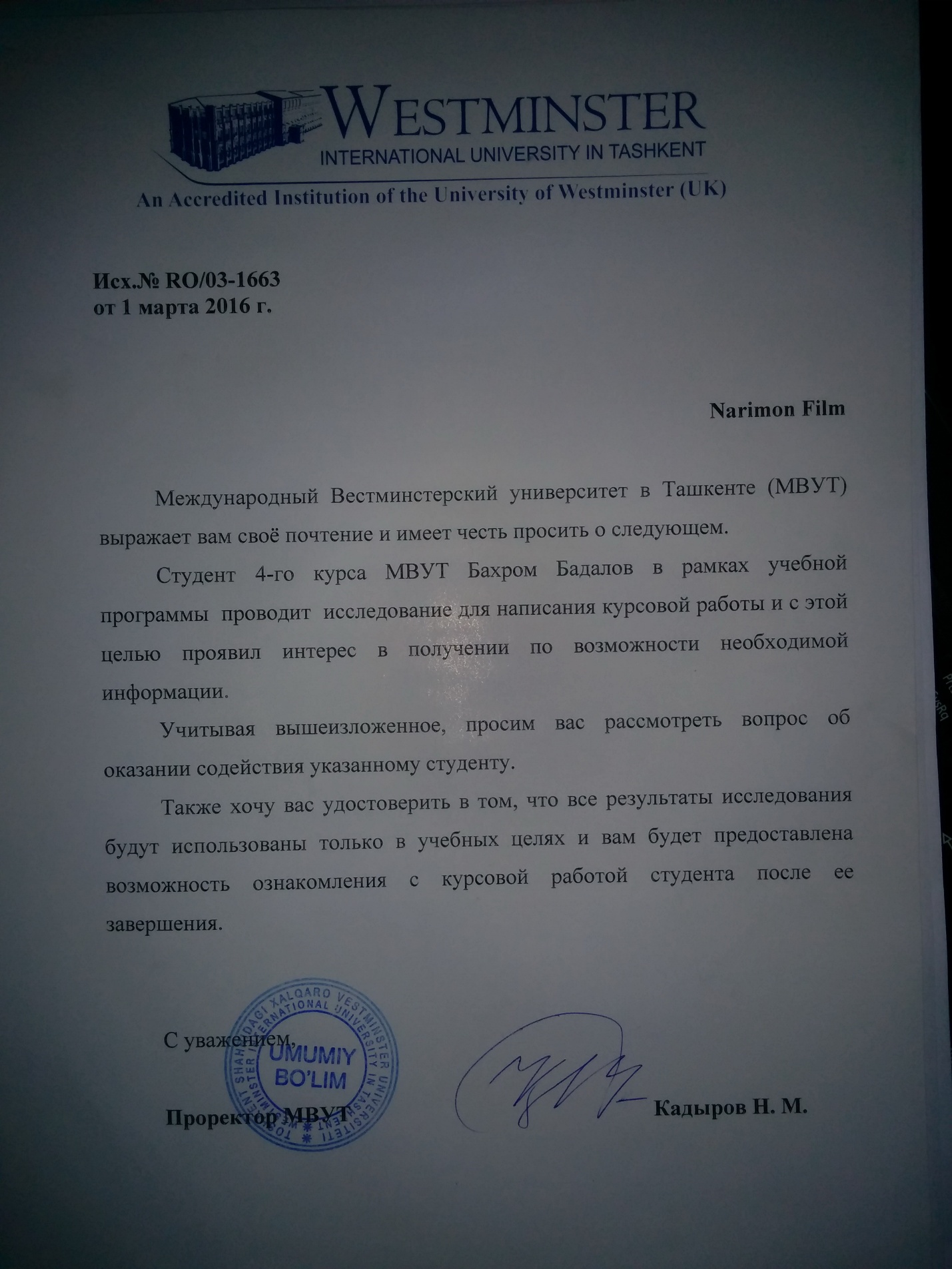
Occupations (Appendix 3)
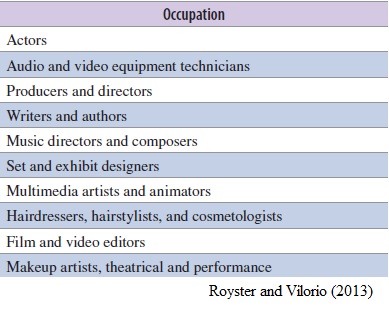
Satisfaction level (Appendix 4)
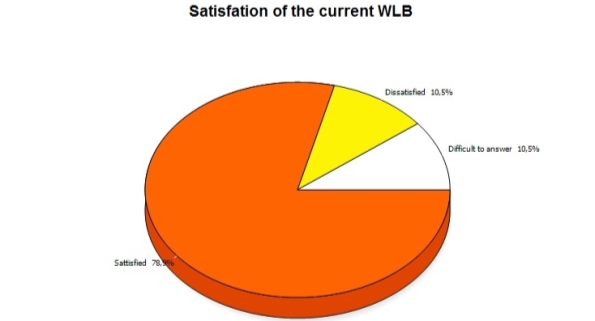
Weather for 23.12.2015 (Appendix 5)

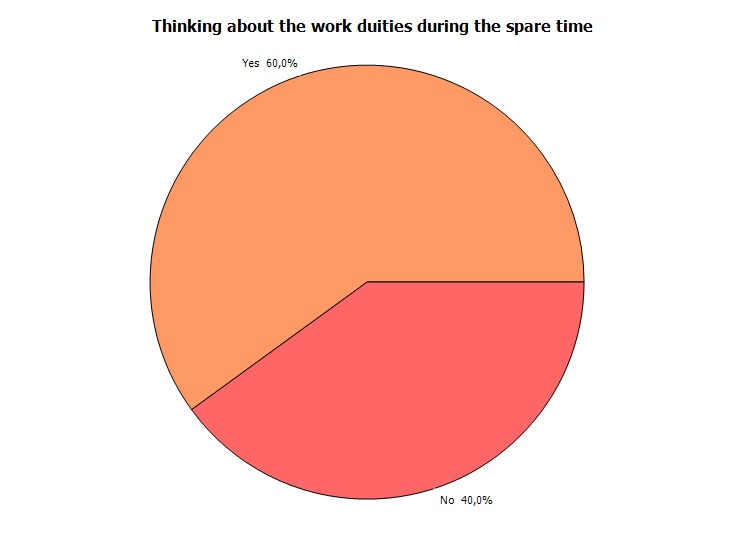
Meeting Logs
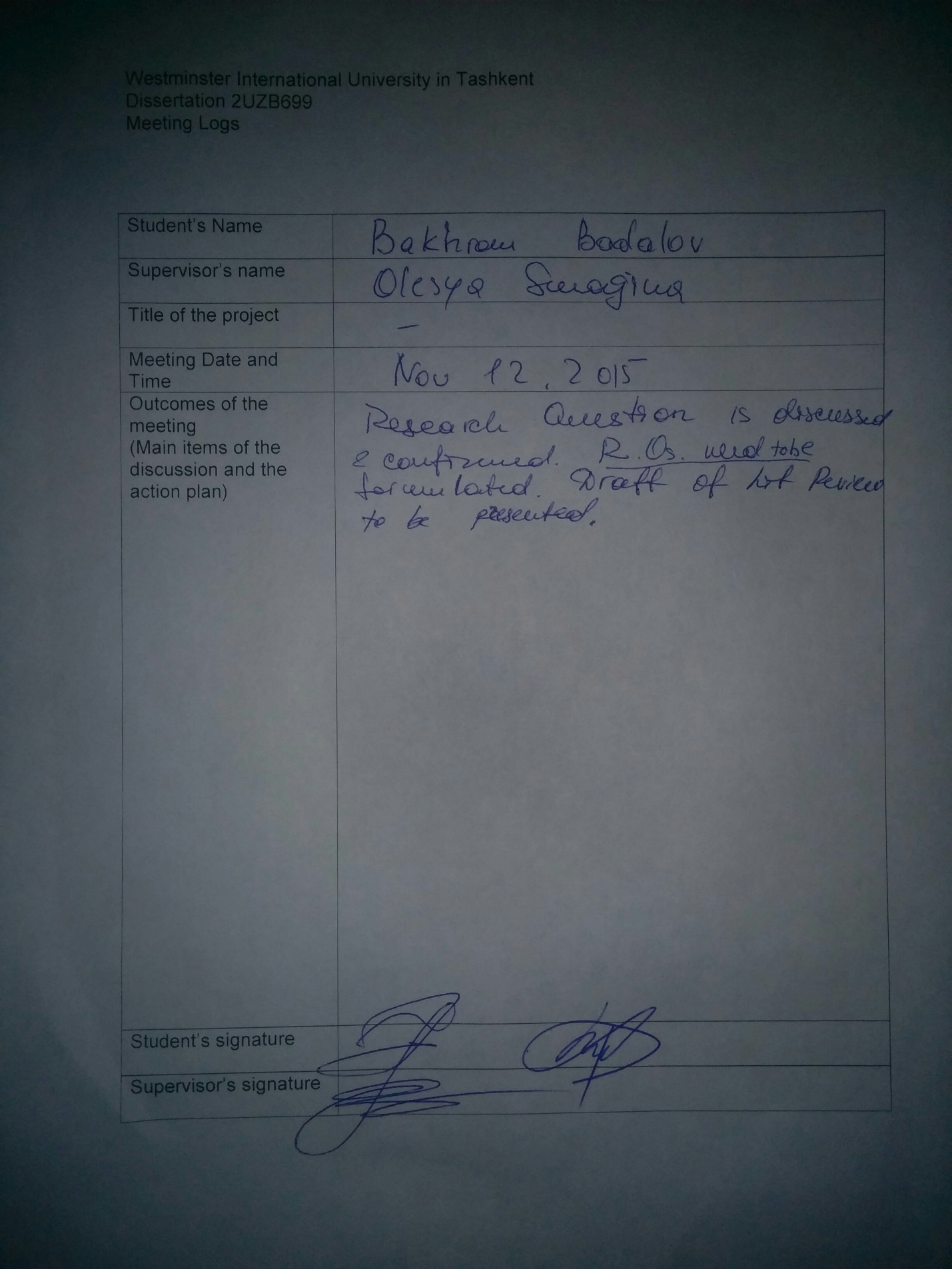
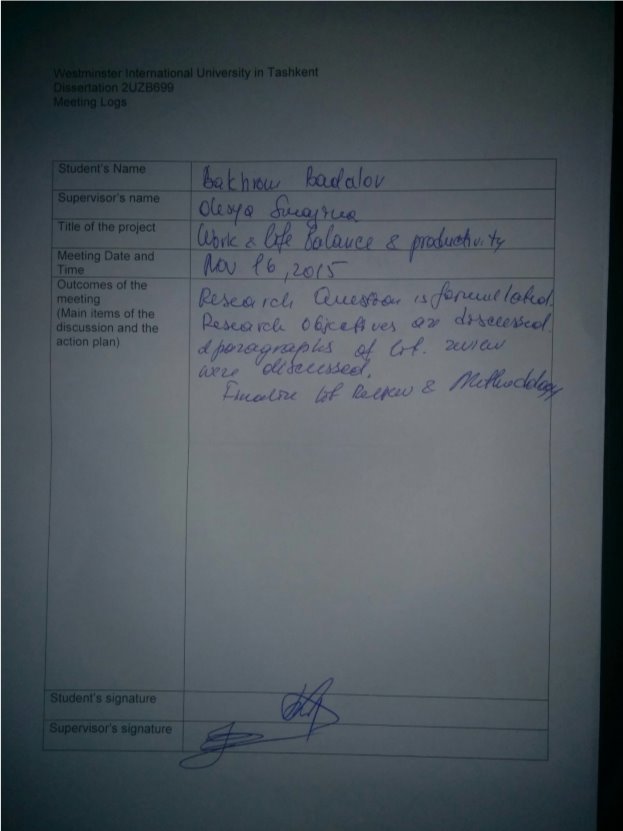
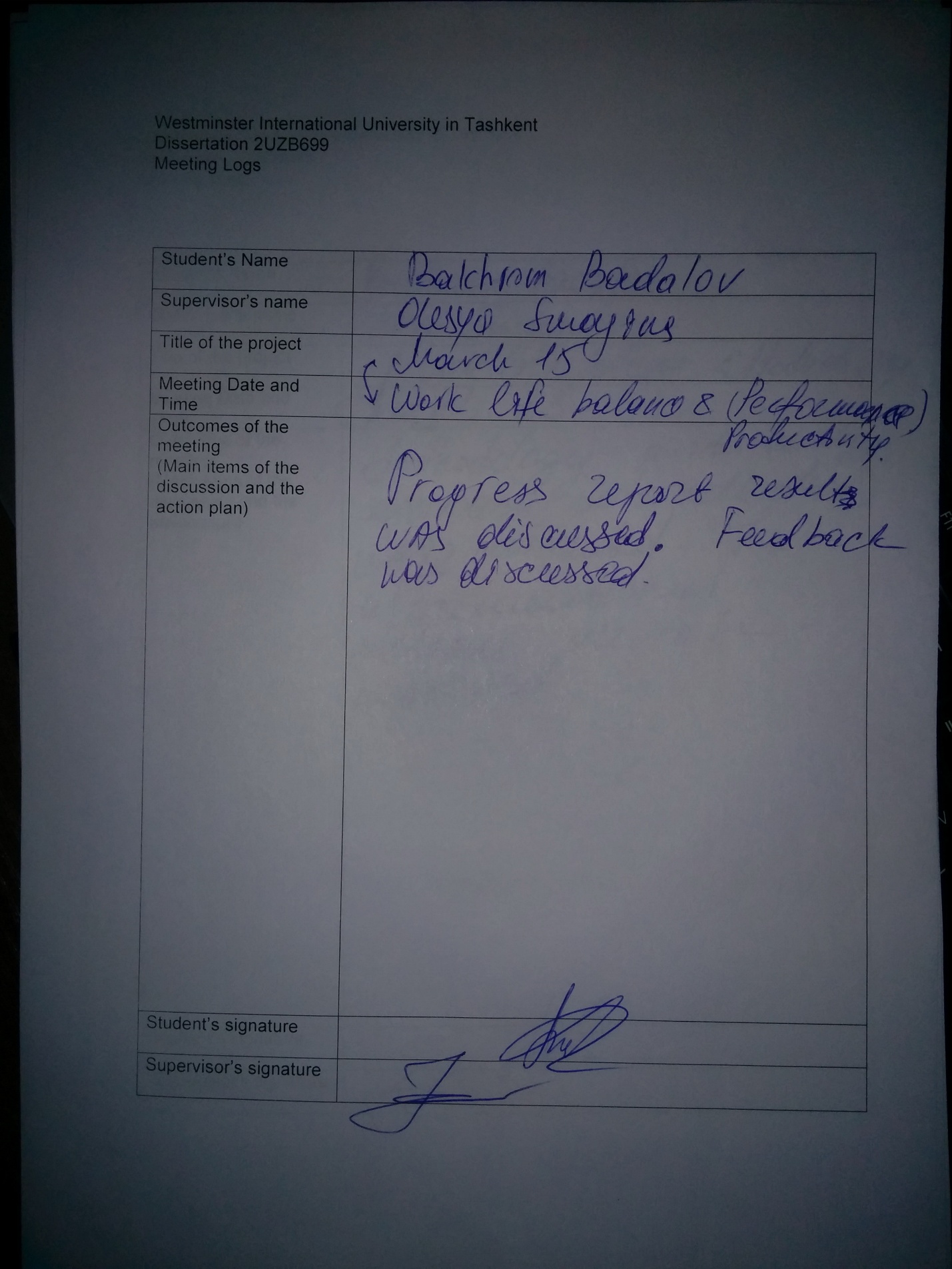
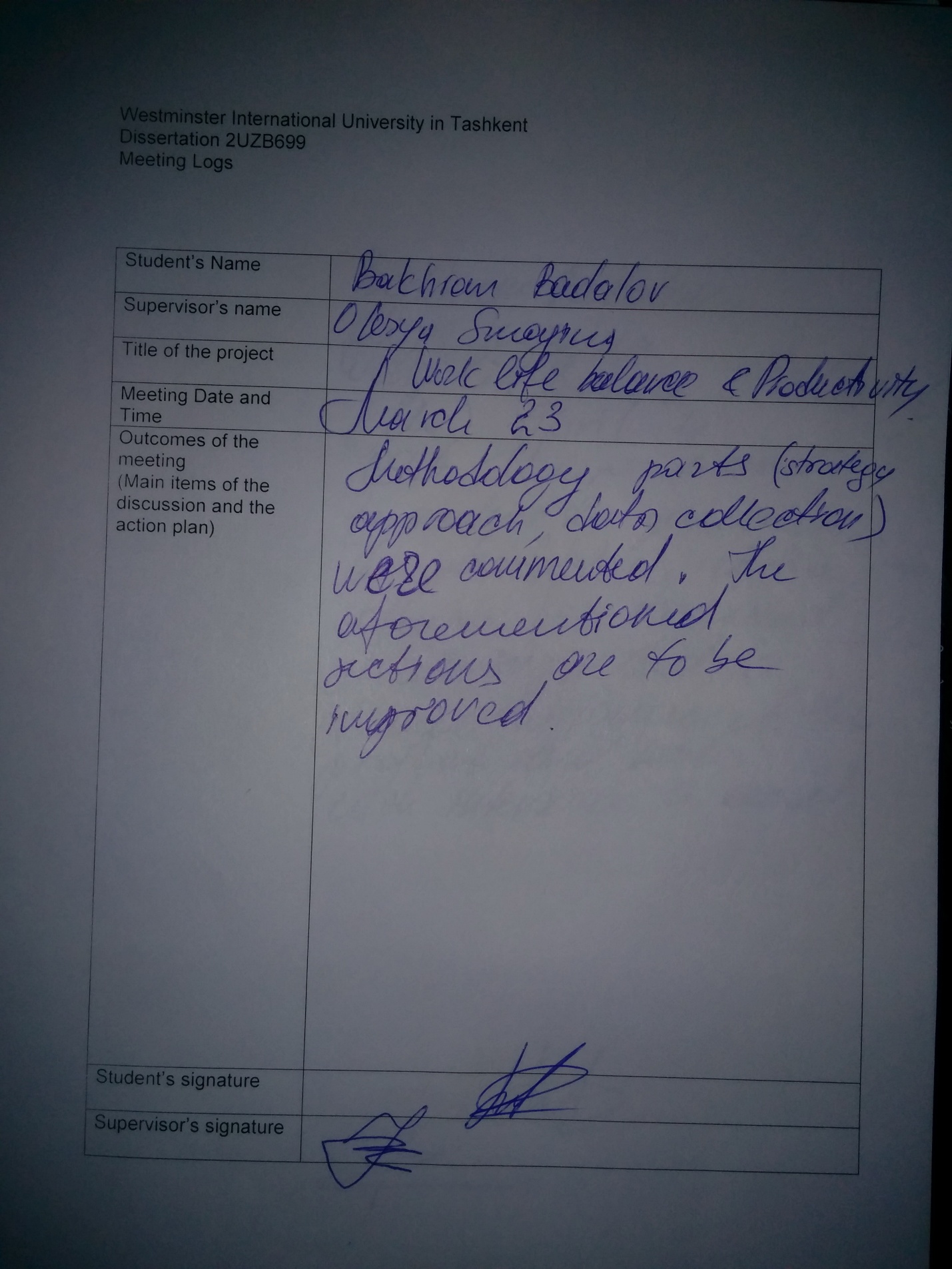
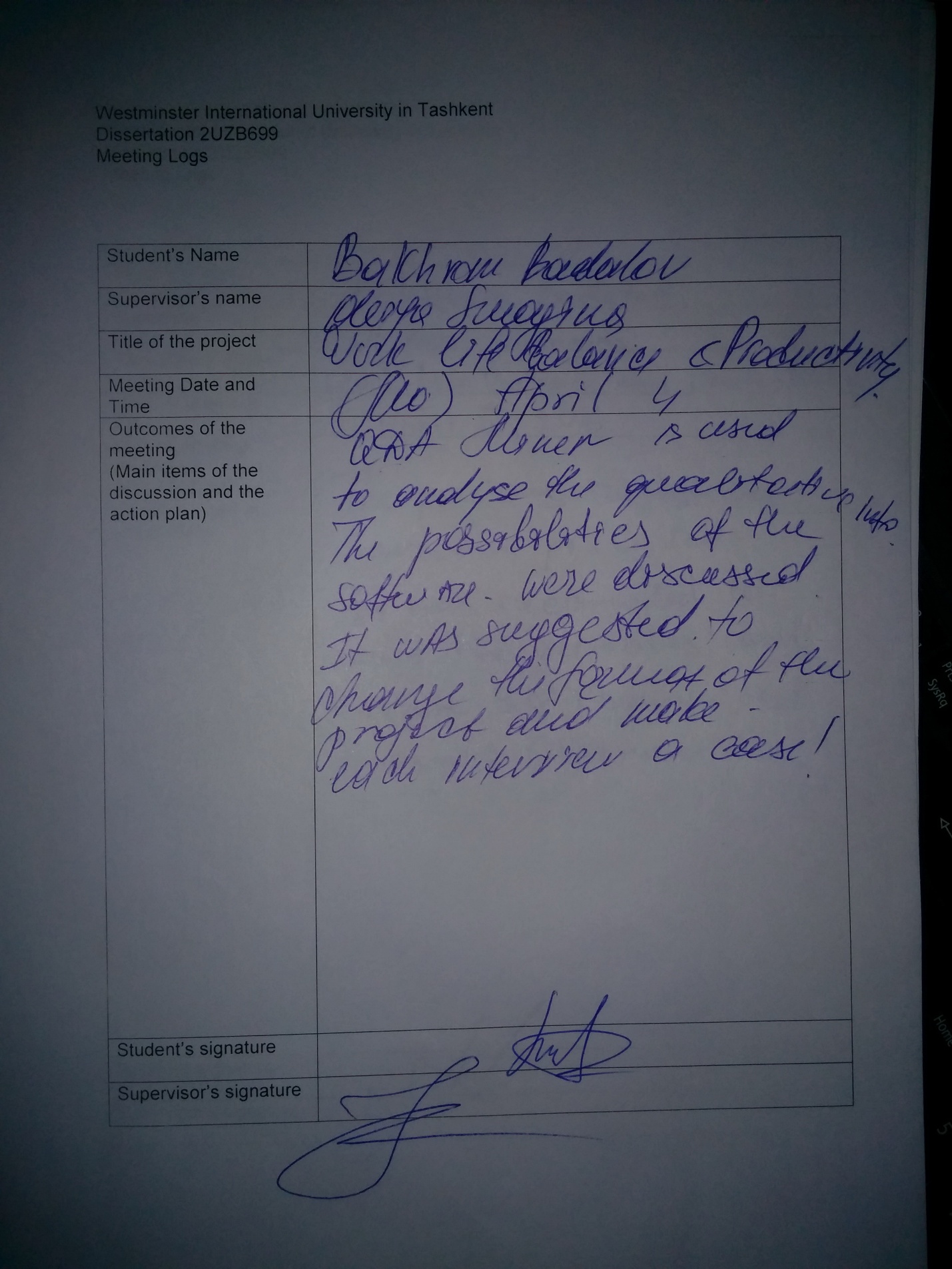
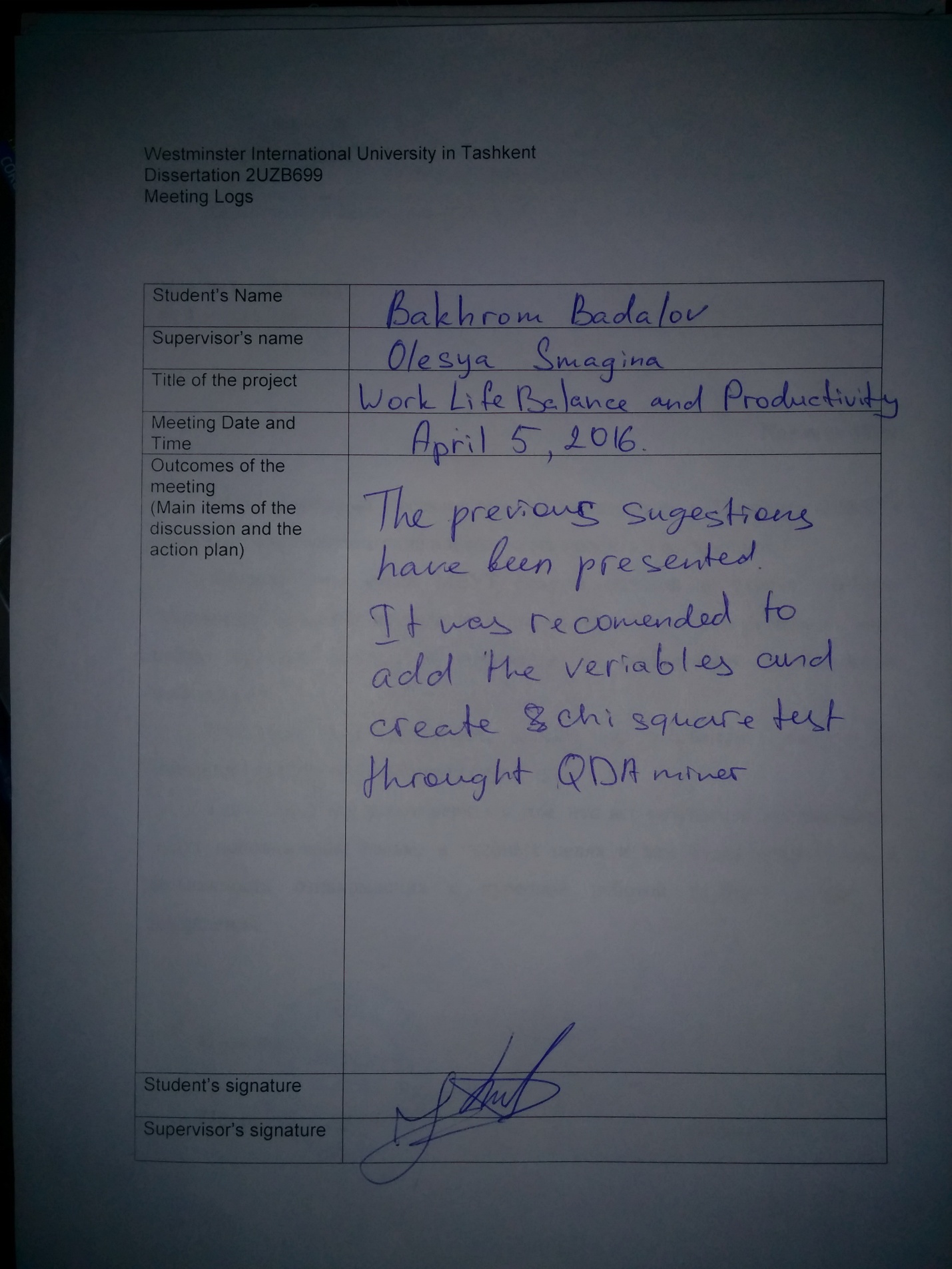
Others
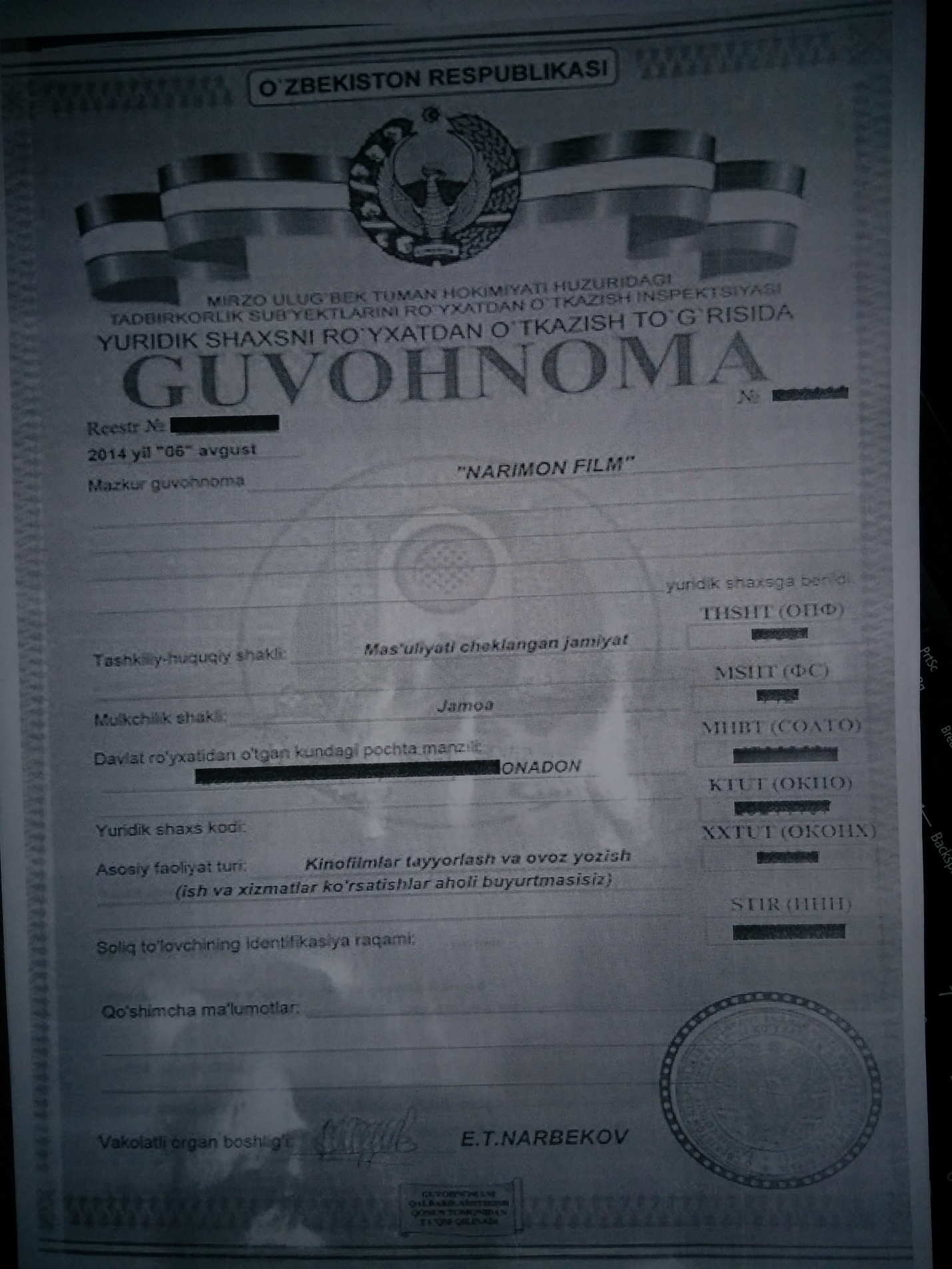

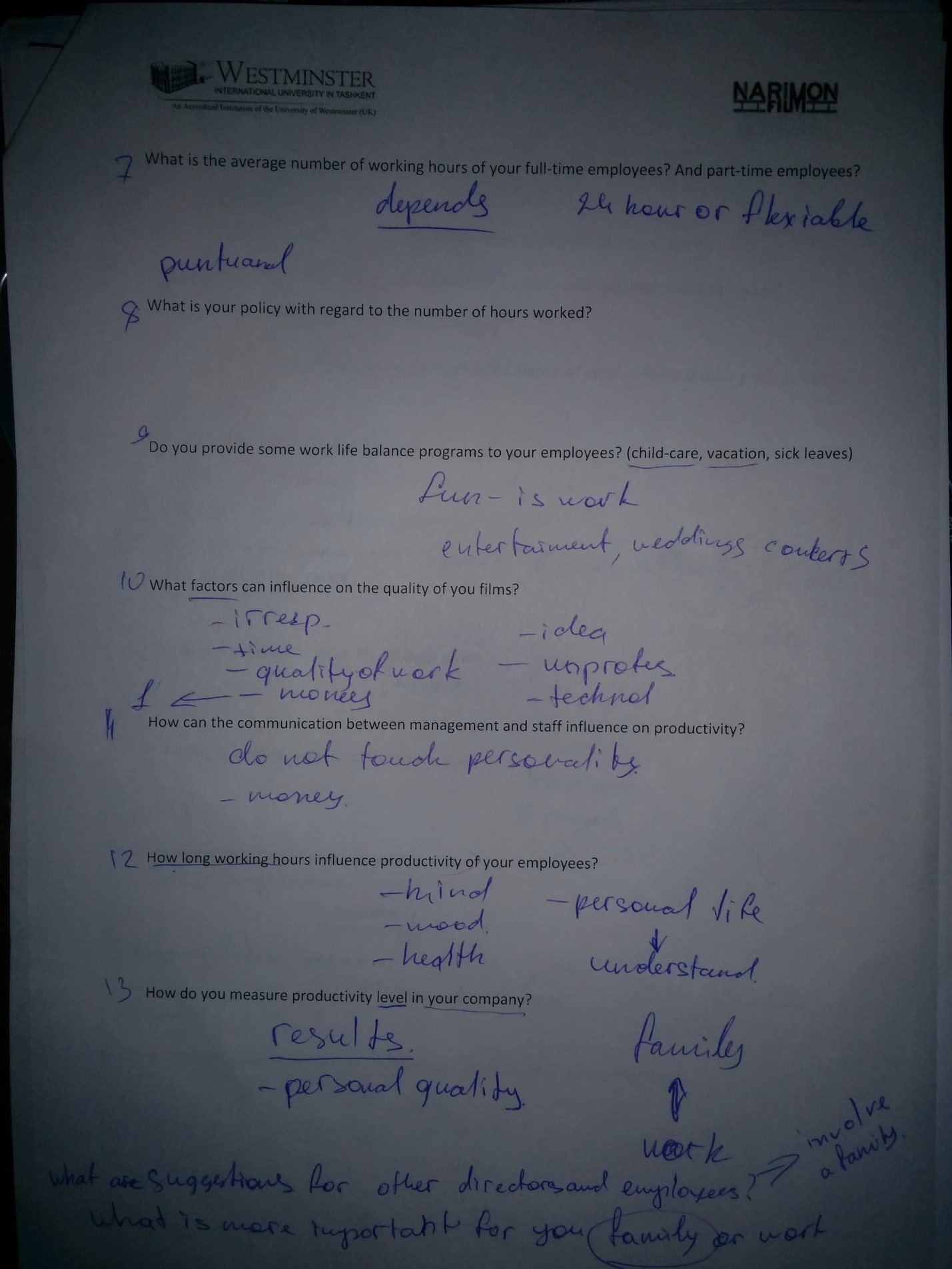



Cite This Work
To export a reference to this article please select a referencing stye below:
Related Services
View allRelated Content
All TagsContent relating to: "Management"
Management involves being responsible for directing others and making decisions on behalf of a company or organisation. Managers will have a number of resources at their disposal, of which they can use where they feel necessary to help people or a company to achieve their goals.
Related Articles
DMCA / Removal Request
If you are the original writer of this dissertation and no longer wish to have your work published on the UKDiss.com website then please:




